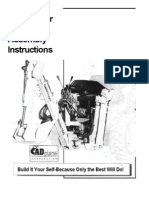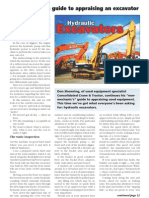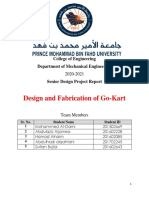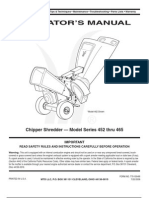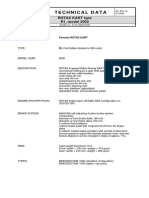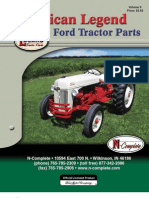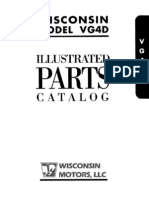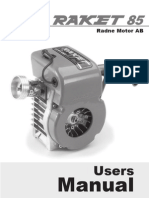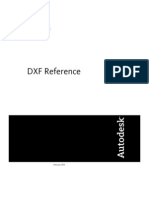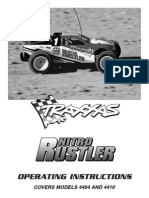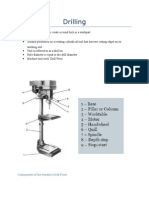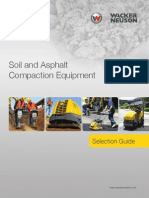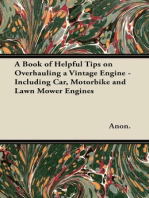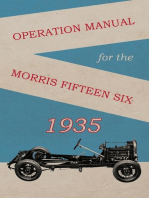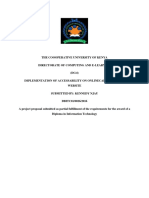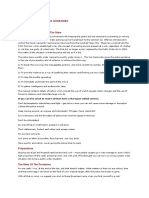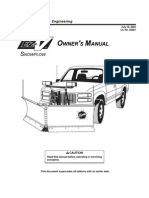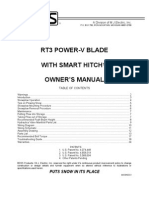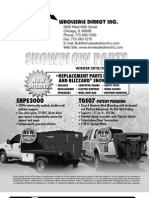Front End Loader
Front End Loader
Uploaded by
ryanmcrae84Copyright:
Available Formats
Front End Loader
Front End Loader
Uploaded by
ryanmcrae84Original Description:
Copyright
Available Formats
Share this document
Did you find this document useful?
Is this content inappropriate?
Copyright:
Available Formats
Front End Loader
Front End Loader
Uploaded by
ryanmcrae84Copyright:
Available Formats
Hydraulic Front-End Bucket Loader for a
Personal Lawn Tractor
A thesis submitted to the
Faculty of the Mechanical Engineering Technology Program
of the University of Cincinnati
in partial fulfillment of the
requirements for the degree of
Bachelor of Science
in Mechanical Engineering Technology
at the College of Engineering & Applied Science
by:
ADAM C. DEHNE
Bachelor of Science University of Cincinnati
May 2012
Faculty Advisor: Laura Caldwell
ii
ACKNOWLEDGEMENTS
I would like to take this opportunity to say Thank You to all of the people that inspired me to
not only complete this project but, also to the people that has inspired me to be a better
person, student, husband, brother, son and friend.
A thank you to my Wife, Andrea Dehne, who helped me to see that education, in general,
and continued education, is extremely beneficial. Also, for supporting me throughout my
degree and this project.
A very special thanks to the companies and individuals that provided sponsorships and
monetary donations. Also, to the individuals who donated their time and to the folks who lent
a hand during the process. The completion of this project may not have been the same
without your contribution. Thank you!
Thank you to the individuals/companies listed below (listed in no particular order):
Andrea Dehne
Teresa Dehne
John Dehne
Cincinnati Hose & Fitting
Shirley Carroll
Curtiss Myers
HydraForce
Doug Rife
Laura Caldwell
Master Pneumatic
Atlas Dowel
David Conrad
Firestone
ISCAR
And to everyone who lent a hand!
Thank you very much,
Adam C. Dehne
iii
TABLE OF CONTENTS
ACKNOWLEDGEMENTS ...................................................................................................... II
TABLE OF CONTENTS ........................................................................................................ III
LIST OF FIGURES ..................................................................................................................V
LIST OF TABLES .................................................................................................................. VI
ABSTRACT ........................................................................................................................... VII
PROBLEM DEFINITION AND RESEARCH ........................................................................ 1
PROBLEM DEFINITION AND BACKGROUND ...................................................................................................... 1
RESEARCH-INTERVIEWS ................................................................................................................................. 2
ONLINE RESEARCH - TECHNOLOGY AND EXISTING PRODUCTS ........................................................................ 2
FRONT-END BUCKET LOADER RESEARCH: ..................................................................................................... 3
RESEARCH SUMMARY:................................................................................................................................... 7
CUSTOMER NEEDS TO ENGINEERED FEATURES ......................................................... 8
CUSTOMER NEEDS/FEATURES ......................................................................................................................... 8
SURVEY FEATURES WITH AVERAGES: ............................................................................................................ 9
PRODUCT/PROTOTYPE FEATURES WITH MODIFIED IMPORTANCE .................................................................... 10
PRODUCT OBJECTIVES ................................................................................................................................. 11
PRODUCT OBJECTIVES SUMMARY ................................................................................................................ 13
PRODUCT/ENGINEERING CHARACTERISTICS WITH RELATIVE IMPORTANCE .................................................... 14
DESIGN .................................................................................................................................. 15
DESIGN ALTERNATIVE ................................................................................................................................. 15
LOAD CAPACITY AND TIP OVER ..................................................................................................................... 16
MECHANICAL SYSTEM OVERVIEW AND SOLID MODEL ................................................................................. 17
BUCKET ...................................................................................................................................................... 18
BUCKET ANALYSIS ...................................................................................................................................... 19
ACCESSORY MOUNT .................................................................................................................................... 20
ACCESSORY MOUNT ANALYSIS ................................................................................................................... 21
LOADER ARMS ............................................................................................................................................ 22
RISERS ........................................................................................................................................................ 23
LOADER ARMS SUPPORTS ............................................................................................................................ 24
LOADER ARM ASSEMBLY ANALYSIS ............................................................................................................ 25
MECHANICAL SYSTEMS PINS AND BUSHINGS ................................................................................................ 26
HYDRAULIC SYSTEM OVERVIEW .................................................................................................................. 27
PUMP .......................................................................................................................................................... 27
TWO GROOVE V-BELT PULLEY .................................................................................................................... 28
SINGLE GROOVE V-BELT PULLEY ................................................................................................................ 29
CUSTOM IN-LINE BELT AND TENSIONER ...................................................................................................... 30
HYDRAULIC CYLINDERS .............................................................................................................................. 31
HYDRAULIC CONTROLLER ........................................................................................................................... 32
FLOW DIVIDER ............................................................................................................................................ 33
HYDRAULIC HOSE AND FITTINGS ................................................................................................................. 34
FABRICATION AND ASSEMBLY ...................................................................................... 35
2-GROOVE V-BELT PULLEY ......................................................................................................................... 35
LOADER BUCKET ......................................................................................................................................... 37
TESTING AND PROOF OF DESIGN................................................................................... 38
iv
ROLLING FEATURE TESTING ........................................................................................................................ 38
FULL LOAD TESTING ................................................................................................................................... 39
PROJECT MANAGEMENT .................................................................................................. 40
SCHEDULE: .................................................................................................................................................. 40
SCHEDULE CONT. ........................................................................................................................................ 41
PROJECT SCHEDULE SUMMARY.................................................................................................................... 41
BUDGET: PROPOSED ..................................................................................................................................... 42
BUDGET: ACTUAL ....................................................................................................................................... 43
CONCLUSION ....................................................................................................................... 44
RECOMMENDATIONS ........................................................................................................ 44
REFERENCES: ...................................................................................................................... 45
APPENDIX A LOADER/PLOW REASEARCH ................................................................. 1
MODEL 50 ASABE INFORMATION ................................................................................................................. 4
APPENDIX B SURVEY WITH RESULTS ......................................................................... 1
APPENDIX C QFD RESULTS ............................................................................................. 1
APPENDIX D - PRODUCT OBJECTIVES ............................................................................ 1
APPENDIX E SCHEDULE .................................................................................................. 1
PROPOSED SCHEDULE .................................................................................................................................... 1
ACTUAL SCHEDULE ....................................................................................................................................... 2
APPENDIX F DIMENSIONAL DRAWINGS ..................................................................... 1
LOADER ARM SUPPORTS (LAS): ....................................................................................................................... 1
RISER: ........................................................................................................................................................... 6
LOADER ARMS: .............................................................................................................................................. 9
CROSS BEAM: .............................................................................................................................................. 10
ACCESSORY MOUNT:.................................................................................................................................... 12
BUCKET: ...................................................................................................................................................... 13
PIN BUSHINGS: ............................................................................................................................................. 25
HYDRAULIC PUMP MOUNT: ........................................................................................................................... 27
HYDRAULIC PUMP - BELT TENSIONER: ........................................................................................................... 31
HYDRAULIC CONTROL MOUNT: ..................................................................................................................... 34
HYDRAULIC CYLINDER(S)............................................................................................................................ 35
TWO GROOVE PULLEY .................................................................................................................................. 36
DIFFERENTIAL FAN SPACER ......................................................................................................................... 37
GAUGE CLUSTER ......................................................................................................................................... 38
FILTER BRACE/BRACKETS ........................................................................................................................... 39
RESERVOIR BRACE/BRACKET ...................................................................................................................... 41
KICK STAND ................................................................................................................................................ 42
FLOW DIVIDER ............................................................................................................................................ 43
APPENDIX G BUDGET ....................................................................................................... 1
v
LIST OF FIGURES
Figure 1: Johnny Bucket Jr. (2)................................................................................................. 3
Figure 2: Husqvarna Front Scoop (3) ....................................................................................... 4
Figure 3: Koyker Loader Model 50 (4)..................................................................................... 5
Figure 4: Craftsman 14 Snow Blade (5) ................................................................................. 6
Figure 5: Johnny Snow Plow (6) .............................................................................................. 7
Figure 6: Surveyed Customer Features ..................................................................................... 9
Figure 7: Features sorted by Relative Weight......................................................................... 10
Figure 8: Top Product Objective............................................................................................. 11
Figure 9: Relative Importance of Engineering Characteristics ............................................... 14
Figure 10: Straight vs. Mitered Loader Arm Configuration ................................................... 15
Figure 11: Systems Center of Gravity Points of Intrest .......................................................... 16
Figure 12: Two position Side View of loader system............................................................. 17
Figure 13: Front Isometric View of Loader System ............................................................... 17
Figure 14: Back Isometric view of the systems Bucket .......................................................... 18
Figure 15:FEA of Bucket ........................................................................................................ 19
Figure 16: Back Isometric view of the Systems Accessory Mount ........................................ 20
Figure 17: Accessory Mount FEA .......................................................................................... 21
Figure 18: System Dead-Lift Point FEA ................................................................................ 21
Figure 19: Cross Beam and Loader Arms............................................................................... 22
Figure 20: Front Isometric view of a single Riser .................................................................. 23
Figure 21: Back Isometric view of an individual LAS ........................................................... 24
Figure 22: FEA of Loader Arm Assembly ............................................................................. 25
Figure 23: FEA of Riser with Factor of Safety Concern ........................................................ 25
Figure 24: Riser with Machined Bushings.............................................................................. 26
Figure 25: Hydraulic Pump ..................................................................................................... 27
Figure 26: Fabricated Two Groove Pulley.............................................................................. 28
Figure 27: Pump Pulley .......................................................................................................... 29
Figure 28: V-Belt Dimensions and Image .............................................................................. 30
Figure 29: In-Line Tensioner .................................................................................................. 30
Figure 30: Systems Hydraulic Cylinders ................................................................................ 31
Figure 31: Hydraulic Joystick Controller ............................................................................... 32
Figure 32: Flow Divider Cross-Sectional View...................................................................... 33
Figure 33: Example of Parker Commercial Grade hydraulic Hose ........................................ 34
Figure 34: Example of Parker O-Ring Style Fittings.............................................................. 34
Figure 35: 2-Groove Pulley Solid Model................................................................................ 35
Figure 36: 2-Groove Pulley Plaster Prototype ........................................................................ 36
Figure 37: 2-Groove Pulley CNC Machined .......................................................................... 36
Figure 38: Assembly of the Bucket ........................................................................................ 37
Figure 39: Milling Operations used for the Bucket ................................................................ 37
Figure 40: Picture of Completed Prototype During Rolling Testing ...................................... 38
Figure 41: Tractor During Full Load Test .............................................................................. 39
vi
LIST OF TABLES
Table 1: Interview Information 2
Table 2: Initial Customer Features 8
Table 3: Scheduled Tasks 41
Table 4: Proposed Budget Overview 42
Table 5: Actual Budget, Condensed 43
vii
ABSTRACT
This is a Report and Design Project that has been developed to aid homeowners in their
landscaping needs. What developed was a proposal for a Hydraulic Front-End Bucket Loader
prototype. This prototype was created to help eliminate the need for an added machine and
expense to a homeowner. This Front-End Loader will be fastened on to the existing frame of
a personal lawn tractor while minimizing modification to it. The hydraulic and mechanical
components of the prototype will be bolted on to the existing frame and chassis components.
The use of light weight material, strong steel joints and bushings allow for the loader to out
preform the current markets competition. One of the largest benefits to this design is that it
allows for the mower desk to stay attached to the tractor while providing Quick Disconnect
features. The quick disconnect features allow for one person operation and storage. The
loader arm and bucket assemblies are completely detachable from the tractor.
This Prototype also allows for a greater load capacity and lift range. The load capacity is
350lb and has enough lift to be able to put loads of mulch, soil and gravel into a ton pickup
truck. The market comparisons for this size tractor are very different. They only allow for a
maximum load of 150lb and lift height of 5-10 inches. This type of minimal load capacity
and lift features limits the homeowners ability to perform normal landscaping task.
Currently, if you want a greater load capacity and lift height you have to purchase a separate
machine to do the job. Normally, this extra machine would be much larger in size and may
become costly to maintain. This is why this Design Project was developed. Thus, the
prototype assists in the elimination of extra storage space and added cost to the homeowner.
All of the components, mechanical and hydraulic, have been developed for a Craftsman/
Husqvarna series lawn tractor (Craftsman Model #07128857000, Mfr. model #28857). Yet, it
is possible to modify and attach this prototype to three (3) other tractor models.
This particular Craftsman Lawn Tractor has a Hydrostatic driveline and integrated safety
features. The beauty of the Loaders Hydraulic System is that it works simultaneously with
the tractors driveline. Yet, the sealed hydraulic system functions completely independent
from it. Another great feature of the hydraulic system is that it utilizes that the same
integrated safety features of tractor. Thus, this eliminates the need for additional wiring
complexity and mechanical safety features that would add expense, weight and complexity
for the home own to maintain.
The hydraulic system utilizes O-Ring seals to help eliminate the potential for leaks and
contamination of the systems. It also has a single joystick controller to allow the operator to
focus on the loading system. The system also, has integrated Dripless hydraulic disconnect
fittings. This not only eliminates potential contamination and lost oil from the system but,
also helps to keep the environment free of added contaminates.
This Design Project has many components to it but, the single most important item is that it
performs. Testing proves that the system completes the tasks and features that it has defined.
Front End Hydraulic Loader for a Lawn Tractor Adam Dehne
1
PROBLEM DEFINITION AND RESEARCH
PROBLEM DEFINITION AND BACKGROUND
Some lawn tractors today have hydraulic drive systems and it would great to tap into that
systems or create one, for other hydraulic applications. Two versatile applications would be a
front-end scoop loader and a snow plow. There are smaller commercial machines that do
these functions but, are very expensive for a normal home owner to acquire.
The proposal is to fabricate a prototype hydraulic front-end loader system (perhaps even be
able to attach other attachments such as a power auger for homeowners to put in fence post,
footings, irrigation heads and more) that will be mounted onto a personal lawn tractor.
There are two main portions/systems of this project. These systems will include the hydraulic
distribution lift system and controls. The second will be bucket/plow lifting assembles and
tractor mounting points.
Front End Hydraulic Loader for a Lawn Tractor Adam Dehne
2
RESEARCH-I NTERVIEWS
A conducted interview with John Dehne (1) took place. He is a corporate engineer who owns
a personal lawn tractor and does a multitude of lawn work at this home. He was interviewed
over the phone on September 25, 2011. The features that he felt would be necessary for the
loader are as follows.
Category Feature Information
Hydraulic and Loader Mechanism
Loader arms do not need to be able to
detach
Attachment(s) need to be removable
Lift: Minimum of 2ft and a Maximum
of 5.5ft
Bucket
Size: Under a cubic yard
Weight: Under 100lb
Bucket pitch: 30 parallel to ground
Snow Plow
Plow movement: Swivel left to right,
up and down
Skid blade or rollers at bottom of
blade
Weight: Light enough for one person
movement
Storage: Plow will be stored when not
in use
(See Appendix A for more). John was able to provide insight to what a real customer would
be looking for when it comes to this front-end loader prototype. He developed three main
categories for the prototype with specific desired features listed above.
ONLINE RESEARCH - TECHNOLOGY AND EXISTI NG PRODUCTS
Research was conducted and as a result 4 main categories were created. Category 1:
Hydraulic system capacity/form/function, Category 2: Loader capacity/form/function,
Category 3: Bucket capacity/form/function and Category 4: Snow Plow
capacity/form/function. 5 web sites were utilized from the internet. Three sites are for
bucket/loader information and two sites refer to snowplow information. Refer to Appendix A
for additional information on the following research objects.
Table 1: Interview Information
Front End Hydraulic Loader for a Lawn Tractor Adam Dehne
3
FRONT-END BUCKET LOADER RESEARCH:
The Johnny Bucket Jr. (fig. 1) is an
electric operated front-end bucket that has
a only 200 lbs. load capacity. It attaches
to the front most extreme portion to the
lawn tractor. One beneficial feature is that
it does not interfere with the mowing deck
but, it lift height capacity is only 10. This
limitation is rather significant when trying
to load into a truck bed. The movement of
the bucket is rather slow. Although, the
system is light weight and the bucket can
swing from 0 (parallel to the ground) -
90 (perpendicular to the ground) via a
push of a button.
Limitations and Advantages:
Limitations; lift height, lift capacity, its
non-adjustability, slow moving bucket
and there is no way to attach a snow plow to it.
Advantages; Moderate weight, Electronic controls, Moderate cost and does not interfere with
the mower deck
Figure 1: Johnny Bucket Jr. (2)
Front End Hydraulic Loader for a Lawn Tractor Adam Dehne
4
The Husqvarna Front Scoop (fig. 2) is a
mechanical, hand lever operated, front-
end bucket loader. It attaches to the front
most extreme portion to the lawn tractor.
This system is less expensive than electric
and hydraulic by the utilization of simple
to use man power lever arms. This
system is not adjustable and only has a
200lbs. lift capacity. The lift height is
rather short as well. Maximum lift is 5-7
from the ground. One benefit of this
system is that it does not interfere with the
mowing deck.
Limitations and Advantages:
Limitations; lift height, lift capacity,
mechanical lift mechanism, its non-
adjustability, many mechanical linkages and there is no way to attach a snow plow to it.
Advantages; light weight, low cost and does not interfere with the mower deck.
Figure 2: Husqvarna Front Scoop (3)
Front End Hydraulic Loader for a Lawn Tractor Adam Dehne
5
Figure 3: Koyker Loader Model 50 (4)
The Koyker Loader Model 50 (fig. 3) is a
hydraulic front-end loader that is intended
to be used with lager tractor/lawn tractor
and/or tractor/lawn tractor without a belly
mounted mowing deck. The load capacity
is much greater than intended use. The
reach and lift height are suitable for
intended use. The cost is much more than
an electrical loader system. The loader
arms are detachable and the bucket is
removable as well but, is not intended to
be a quick disconnect accessory. The
systems maximum dump angle is 37 and
the digging depth is 3.
Limitations and Advantages:
Limitations; non-adjustability, cost, non-
quick disconnect accessories, must be
used with a larger tractor or with one that has no mowing deck and there is no way to attach a
snow plow to it.
Advantages; Lift and load capacity is appropriate, bucket reach and lift height is appropriate,
sealed hydraulic system
Front End Hydraulic Loader for a Lawn Tractor Adam Dehne
6
Snow Plow research information:
The Craftsman 14 Snow Blade (fig. 4) is
a mechanical (lever arm) snow plow
system. This snow plow system is not
power and attaches to the front most
extreme portion to the lawn tractor. It
does not interfere with the mowing deck
and is light weight. The blade can swivel
from left to right to divert snow. Use of a
hand lever is needed to lift/lower plow
and a hand grip is used to release a pin so
that the plow may swivel left to right. The
blade/plow is removable with only one
person for maintenance but, is not
intended to be a quick disconnect
accessory. The scraper blade at the
bottom of the plow is removable to
replacement/maintenance.
Limitations and Advantages:
Limitations; mechanical lift mechanism, many mechanical linkages and there is no way to
attach a loader bucket to it.
Advantages; light weight, low cost, replaceable scraper blade, swivels from left to right and
does not interfere with the mower deck.
Figure 4: Craftsman 14 Snow Blade (5)
Front End Hydraulic Loader for a Lawn Tractor Adam Dehne
7
The Johnny Snow Plow (fig. 5) is an
electric operated system. This system is
intended to be an add-on to the Johnny
Bucket Jr. system or can be purchased as
a whole system. It attaches to the front
most extreme portion to the lawn tractor.
It does not interfere with the mowing
deck. Its weight is moderate and the plow
does swivel left-to-right and up and down
for snow diversion. The movement is
done electronically but, is minimal and is
slow moving. All of the controls are
electronic and the plow does have a
removable/replicable scraper blade.
Limitations and Advantages:
Limitations; lift height, slow moving
Advantages; Moderate weight, swivels from left to right, Moderate cost (is more costly when
purchased independently from Johnny Bucket Jr. system) and does not interfere with the
mower deck
RESEARCH SUMMARY:
The interview and the major systems above, generate information that is used to develop
specific customer needs and possible features for this prototype.
Figure 5: Johnny Snow Plow (6)
Front End Hydraulic Loader for a Lawn Tractor Adam Dehne
8
CUSTOMER NEEDS TO ENGINEERED FEATURES
CUSTOMER NEEDS/FEATURES
Initial customer features, listed below, are needed in order to zero in on what could be
potentially implemented into the design of the front-end loader. Below, in Table 2, are a
General List of customer features and a Condensed List to the right of it.
These two lists are the building blocks of the future function/features of the prototype. The
left side list offers ideas of features that could be implemented. These were developed from
research and potential personal needed features. The right hand side lists are words and/or
phrases that provide parallel thoughts towards the importance of the potential features.
General List:
Condensed List:
...is important
Safety switch- will not be able to operate without
sitting on tractor
Safety
Snow plow will have a removal scraper blade Ease of Maintenance
Hydraulic lever controlled
Easy to operate with simple instructions
Ease of Use
Be hydraulically driven
Will be able to attach/detach bucket/plow, also do so
with one person
Will be able to attach/detach hydraulics/mech. arms,
also do so with one person
One Person Operation
Lift 5-6ft of ground
Dig 1-5 into ground
Snow plow will be able to swivel left and right
The ability to perform operational and functional task
Uses of commercial and quality grade
material/components/fasteners
Durability/Reliability
Will be painted/powder coated for easy cleaning Ease of Cleaning
Uses of current model tractor Compatibility with Existing lawn tractor models
Ability to lift 400-500lb load while staying in
temperature range of engine and hydraulics
Staying within the limits of the tractor
Bucket Capacity
Operate with reasonable speeds Speed of Operation
Ability to lift 400-500lb load while staying in
temperature range of engine and hydraulics
Operation temperature
Quick disconnect hydraulic lines for easy removal
Kick stand for lever arms so that it stands up after
removal
Ease of Storage
As seen above - The General list changed into the new Condensed List. The new list was
written to clarify a feature and it was written in such a way to keep parallelism between each
feature. Each feature from the Condensed List is to be read as, Feature is important.
These are important to the potential function/design of the prototype. This new list is used in
the creation of the survey features for the prototype. The survey is seen in the category.
Table 2: Initial Customer Features
Front End Hydraulic Loader for a Lawn Tractor Adam Dehne
9
SURVEY FEATURES WI TH AVERAGES:
Figure 6 is a list of Surveyed Customer Features (see Appendix B). There were 22 surveys
returned and tabulated. The people surveyed ranged from engineers and business owners in
the construction and hydraulic industry, to engineers and business owner with a mechanical
background and to engineering student that would have insight to the design features of the
prototype. These items will help depict what feature and objectives will be utilized in the
design. They are listed from highest to lowest average rating.
The list above shows that the surveyed peoples deemed that Durability/Reliability should rate
the most important with an average of 4.6%. Ease of Storage is the lowest rated at 3.0%.
Even though there is a top rated and lowest rated feature the averages are not very far apart.
All of the features surveyed fall within the top 60%. There is not a distinctive most or least
important features to consider. There is only a 35 % difference between each feature.
A note: The survey sent out to be filled out and returned. The second portion of the survey
has been omitted. This section was for Customer Satisfaction. The section was placed on
the survey in order to receive information from individuals that have owned/used a front-end
loader on another device. Only 5 out of 22 surveys collected had this section filled out. There
were not enough data points from this section available in order to deem this information
valuable.
Survey Feature/Item Avg (out of 5)
Durability/Reliability 4.6
Safety 4.6
Ability to preform Operational Task 4.6
Ease of Use 4.4
Compatibility with current tractor models 4.1
Ease of maintenance 4.1
Overall Cost 3.9
Stay within limits of tractor used 3.9
Bucket Capacity 3.5
Speed of Operation 3.2
Operation Temperature 3.0
Ease of Storage 3.0
Figure 6: Surveyed Customer Features
Front End Hydraulic Loader for a Lawn Tractor Adam Dehne
10
PRODUCT/PROTOTYPE FEATURES WI TH MODIFIED IMPORTANCE
A House of Quality or QFD (see Appendix C) is a tool used that utilizes survey results,
customer features and engineering characteristics to weights of importance to specific design
areas. Figure 7 illustrates these weights of importance and how they were derived.
Using the Designers Multiplier, it allows for the ability to slightly modify the results (
20%). This modification is sometimes necessary to aid in the display of the designers thought
process for each function/feature of the designed prototype. The Relative Weight depicts the
importance of each function/feature. The importance may change the importance order of the
Prototype features.
The only features that were not modified were Durability/Reliability and Operational
Temperature. These features were not modifies because the results that came from the survey
were deemed appropriate for the design of the prototype.
All of the others were slightly modified with in the 20% range. The design features that
were modified positively were done so because these were functional features of the
prototype. The system needs to function as intended.
The other features, such as Safety, Compatibility, Maintenance and Cost may not directly
affect the functions/features of the prototype. Notice they were not significantly reduced.
These features were only reduced 10% out of the potential 20% maximum. The Designers
Multiplier is not intended to completely Out-Do the survey results yet, it is intended to
modify or adjust the result slightly toward some design objective.
Prototype Features
Designer's
Multiplier
Modified
Importance
Relative
weight %
Ability to preform Operational Task 1.2 5.5 11%
Ease of Use 1.1 4.9 10%
Durability/Reliability 1.0 4.6 10%
Stay within limits of tractor used 1.2 4.6 10%
Safety 0.9 4.1 9%
Bucket/Plow Capacity 1.1 3.8 8%
Compatibility w/current tractor Models 0.9 3.7 8%
Ease of Maintenance 0.9 3.7 8%
Overall Cost 0.9 3.5 7%
Speed of Operation 1.1 3.5 7%
Ease of Storage 1.2 3.4 7%
Operation Temperature 1.0 3.0 6%
Figure 7: Features sorted by Relative Weight
Front End Hydraulic Loader for a Lawn Tractor Adam Dehne
11
PRODUCT OBJ ECTIVES
The top weighted product objective is shown below. Note: There are 12 total objectives (see
fig. 9; also, see appendix D for more detail). The Top two Products Objectives are the most
important to the design and to the function/features of the prototype. The loader has to
function, period. This is what the main goal of the project and is also the top rated product
objective. Above are the listed features definitions for the objective, Ability to perform
Operational Task. The second most important objective is, Ease of Use. One person
operation and the use of hydraulic components with provide the system with easy functional
use.
The Relative Importance Percentage (fig. 9) was derived from the use of the QFD (appendix
C). These Product Objectives were developed in order to define the function/features of the
prototype by the designer. These are next building blocks for the front-end loader design.
The other 13 objectives are just important to the overall completion of the project but, they
have a lower importance weight for the prototype feature/functions. Below is a list of them.
The objectives title and importance weight for them are listed in bold text. A collection of
definitions created for each objective is below that.
Ease of Use (10%):
1. One person operation
a. Attachments able to be attached and removed with one person of average size
b. Controls to be used with one person of average size
2. Controls will be within an appropriate reach of steering wheel for an average size
person
3. Hydraulics will be designed to be able to be use with tractors engine HP/Torque
4. Loader will operate when drive line is engaged
Durability / Reliability (10%):
1. Bucket wear surfaces will be selected based on hardness
2. Utilize reliable components/material determined by safety/service factors and for
particular application requirements
3. All hardware used will be Grade 2 and higher
Figure 8: Top Product Objective
Ability to perform Operational Task (11%):
1. Lift bucket load of 400-500lb to a reasonable height to load into a Ton Truck bed
2. Dig 1-5in in to soft ground/soil (Note: weather and lawn conditions must be with in
tractors operational limitations)
3. Snow plow will be able to swivel left and right for snow defection
4. Dead lift load capacity from single point
Front End Hydraulic Loader for a Lawn Tractor Adam Dehne
12
4. All hoses, hard lines and fittings will be commercial grade
5. Fittings will not leak during test period
6. Loader (as a whole) will preformed intended functions during the test period (Note:
tractors durability/reliability will not be a determining factor of loaders
durability/reliability)
7. Also, See Ease of Maintenance No. 1-5
Stay within limits of tractor used (10%):
1. Lift capacity (load units in lbs.) at max height and reach may be 30% less than total
lift capacity (limits TBD)
2. Hydraulic components and sizes of them, will be assigned, dependent on space
available within tractor
3. Bucket load and loader lift capacity may change dependent No. 1-2 above
4. Tractor will move on level ground with bucket loaded
5. Also, See Bucket Capacity Note No. 1
Safety (9%):
1. Lift arm controls will not be operable when operator is not seated on tractors seat
(Note: Bucket may lower due to gravity/normal valve fluid bypass and leakage as
well as when lowering action is activated)
2. Bucket capacity will be sized so that at full load tractor will not tip
3. Loader drive system will not operate if its operator leaves tractor seat
4. Hydraulic fluid temperature can be monitored with a gauge
5. Hydraulic fluid filter/screen will be used in system
6. Loader arm kickstand will provide rollover resistance on flat ground
7. Components that rotate/move, have driven belt, have pinch points, that are hot to
touch and/or that have potential to injure the operator or other persons will have
appropriate guards and/or caution labels/placards attached (Note: any item that is
mentioned above (Safety No. 7) that is in an open area but, within the frame/chassis
will not be required to have a guard and/or caution label/placard)
8. Also, See Stay within limits of tractor used feature below
Bucket/Plow Capacity (8%):
1. Goal: four-five (4-5) cubic feet for soil (Capacity created by average soil weight from
dry to wet (i.e. 100lb avg. per cu/ft)) Note: this is dependent on tractors abilities (i.e.
tipping factor and load capacity). Otherwise bucket capacity will be adjusted
appropriately.
2. Snow plow will be 10-14 tall and 38-42 wide
Ease of Maintenance (8%):
1. All steel components will be painted or powder coated
2. Hardware will be Stainless and/or galvanized and/or painted or pre-coated with an
anti-corrosion
3. Sealed bearing will be use were applicably
4. Fluid filter/screen
a. A person with average hand size and arm length will be able to access it
Front End Hydraulic Loader for a Lawn Tractor Adam Dehne
13
b. Uses of standard tools may be required
5. Grease fittings (applied to system where appropriate)
a. A person with average hand size and arm length will be able to access them
b. Uses of standard tools may be required
6. Snow plow will have a removal-able bottom scraper blade
7. Also, See Ease of Storage No. 3
Compatibility with current tractor models (8%):
1. To be designed for Craftsman/Husqvarna series lawn tractor (similar but, not limited
to, item Craftsman Model #07128857000, Mfr. model #28857)
Speed of Operation (7%):
1. Raise time unloaded 6sec
2. Lowering time 6sec
Ease of Storage (7%):
1. Attachments detach from lifting arms using standard hand tools
2. Loader arm has ability to detach from tractor using standard hand tools
3. Loader arm has kickstand so that it does not roll/fall over after it is detached from
tractor (on flat, solid ground)
4. Hydraulic hoses have quick disconnect fittings (where deemed appropriate by design)
Overall Cost (7%)
1. Prototype will be no more than 20% over projected budget.
Operation Temperature (6%):
1. Fluid temperature to stay under manufactures recommendation
PRODUCT OBJ ECTIVES SUMMARY
The list is from 11% to 6%, which is the make-up of importance for each objective. There is
no clear winner or loser (Except for the top and bottom of the list). Only one percent divides
each objective. This makes for a good decision environment because all fall in order without
being too farfetched. Yet, since all of them are very close together that means many of them
may rely on its neighbor for success at a particular feature/function of the prototype.
Front End Hydraulic Loader for a Lawn Tractor Adam Dehne
14
PRODUCT/ENGINEERING CHARACTERISTICS WI TH RELATIVE IMPORTANCE
Figure 9 depicts the Relative Importance between the function/feature of the prototype and the Engineering Characteristics.
The strongest relationship between them is Component Selection for the entire system. This relationship does make the most
amount of sense. Everything revolves around the selection of components in order to not only complete the project but, for it
to be a success and function properly.
There are 15 different Engineering Characteristics to consider. They all have been deemed to
have either a Strong, Medium or Weak relationship in relation to the Prototype Features in
Figure 7. The range of Relative Importance is from 14.60% (This majority is driven by
physical dimensions of the tractor and geometry of the load arms) to as low as 2.65% with
Collision & Abrasion Resistance.
The figure above does not show a list of characteristics of the system yet, an illustration of
how the features of the prototype with interact with them. Figure 7 and 8 are a very important
initial pieces of the proverbial puzzle we call this Senior Design Project. These two figures
aid in the initial steps to determine components/material cost and the budgeting for them.
Also, aids in particular design aspects for specific features of the loader system. Refer to
Appendix C.
Engineering
Characteristics
Rel.
Importance
Component
Selection
14.60%
Load Capacity 14.49%
Bucket Height
and Reach
10.09%
Weight 9.29%
Size 8.64%
Material
Selection
6.92%
Operation while
drive line
Engaged
6.23%
Engineering
Characteristics
Rel.
Importance
Raise and lower
time
5.31%
Replaceable
Components
4.40%
Removable
Attachments/
Accessories
4.32%
Attachments/
Accessories Roll
Resistance
3.58%
Attachments/
Accessories
Flexability
3.54%
Safety and
Service factors
3.30%
Guarding and
Signage
2.65%
Collision &
Abrasion
Resistance
2.65%
Figure 9: Relative Importance of Engineering Characteristics
Front End Hydraulic Loader for a Lawn Tractor Adam Dehne
15
DESIGN
DESIGN ALTERNATIVE
Shown below, in Figure 10, are two different configurations considered for the Loader Arm
configuration. The configuration selected for the project is the Mitered Loader Arm. This is
mainly due to mechanical similarity to other researched loader arm system configurations.
This mechanical similarity is enough for the selection, even without other investigations. Yet,
in order to choose a winner between the two, other investigations have taken place.
Some other investigational items to note is that there is a higher probability that the straight
loader geometry will interfere with the tractors body panels. Also, the mitered configuration
may allow for longer lift cylinder to be installed. This is an important aspect in order to
achieve the desired lift capacity of the system.
Observe Location A (for both images) on figure 10. They are both the same approximate
heights yet, the two individual cylinder strokes are at different positions/rates. The straight
loader arm configuration is at 100% of its cylinder stroke; while, the Mitered configuration
cylinder is only at 80% stroke. Also, observe location B. These two heights are not the
same. The mitered systems height is approximately 25% higher than the Straight system. Yet,
both systems cylinders are at 50% stroke. This provides additional lifting potential needed
the desired lift height capacity.
Figure 10: Straight vs. Mitered Loader Arm Configuration
Front End Hydraulic Loader for a Lawn Tractor Adam Dehne
16
LOAD CAPACITY AND TI P OVER
Load capacity and tip-over are important considerations and calculations. Figure 11
illustrates the particular points of interest and their CG within the system. This figure aids in
the calculation of a maximum load capacity within the bucket at point C. The equations
used are shown below:
Without an operator seated:
If B
y
= 0
Then C = 225 lb.
With an operator seated during operation of loader system:
If B
y
= 0
Then C = 425 lb.
Figure 11: Systems Center of Gravity Points of Intrest
Therefore the theoretical load capacity is 425 lb. Yet, due to potential load applied to the
tractors axels and the designed loader arms, the Maximum load capacity will be 350lb.
Front End Hydraulic Loader for a Lawn Tractor Adam Dehne
17
MECHANICAL SYSTEM OVERVIEW AND SOLID MODEL
There are five main components within the mechanical portion of the loader system. Figure
12 illustrates these components at ground and maximum reach positioning. Figure 13
illustrates a front Isometric view of the mechanical system. See Appendix F for Dimensional
Drawings of individual components that make up the Mechanical Systems Assembly and
Sub-components.
Figure 12: Two position Side View of loader system
Figure 13: Front Isometric View of Loader System
Bucket
Accessory
Mount
Loader
Arms
Loader Arms
Supports
Riser
Front End Hydraulic Loader for a Lawn Tractor Adam Dehne
18
BUCKET
The Bucket has an approximate volume of 2.75ft
3
and an approximate weight is 50lb.
Also, it is designed to have a Quick Disconnect feature, in conjunction with the Accessory
Mount. This is for ease of storage and for future use of accessories. This function utilizes
the two upper Hooks on the back of the bucket and the two lower Pin Holding Tubes.
These are illustrated in figure 14 bellow. See Appendix F for Dimensional Drawing of
individual components that make up the Bucket assembly.
Figure 14: Back Isometric view of the systems Bucket
The buckets main function is to scoop loose mulch, soil and gravel. The load capacity of the
whole system is 350lb and is intended to be an even load distribution with in the bucket. The
buckets physical design was done so that it will be able to scoop a full bucket of dry clean
gravel. This would be heaviest and worst-case scenario.
Mounting Hooks
Pin Holding Tubes
Front End Hydraulic Loader for a Lawn Tractor Adam Dehne
19
BUCKET ANALYSIS
Figure 15 below, is a COSMOS FEA image of the designed bucket for the system. You are
looking at the bottom of the bucket in order to see the large majority of stress being applied.
This analysis was done with a fully loaded and evenly distributed loading situation.
Figure 15:FEA of Bucket
The Yield of the material is 350Mpa and the largest Stress being applied to the bucket is
90Mpa. This provides a large safety factor for this component.
Front End Hydraulic Loader for a Lawn Tractor Adam Dehne
20
ACCESSORY MOUNT
The Accessory Mount is an intermediate between the Bucket and the Loader Arms. It
weighs about 22lb and has the mating feature for the buckets Quick Disconnect functions.
It also connects to the Bucket Hydraulic Cylinder. Just below the cylinder mounting plate is a
Dead Lift point so that the Loader could lift the total load capacity at a single point. Figure
16 shows the Accessory Mount and its features. See Appendix F for Dimensional Drawings
of individual components that make up the Accessory Mount assembly.
Figure 16: Back Isometric view of the Systems Accessory Mount
Cylinder
Attachment Plates
Front End Hydraulic Loader for a Lawn Tractor Adam Dehne
21
ACCESSORY MOUNT ANALYSIS
Figure 17 below, is a COSMOS FEA image of the designed Accessory Mount for the system.
The material Yield is 250Mpa and the largest stress observed is 17Mpa. This provides and
large safety factor for this portion of the mechanical system.
Figure 17: Accessory Mount FEA
Figure 18: System Dead-Lift Point FEA
The FEA done for the Dead-Lift point for the system is shown in figure 18 above. The
analysis was done on a hardened pin. A full 350lb load was applied and supply a safety
factor of 11.
Front End Hydraulic Loader for a Lawn Tractor Adam Dehne
22
LOADER ARMS
The Loader Arms provide the primary movement for the system. They have a central
loader arm Cylinder Attachment Plate. The configurations of the arms are such that they
provide enough height to raise the Bucket to the desired lift height. The Cross Beam spans
between the two arm to aid in the prevention of twisting under a load. Figure 19 shows both
the Right Side Loader Arm and the Cross Beam that spans between the two arms.
Figure 19: Cross Beam and Loader Arms
See Appendix F for more information and dimensional Drawings.
Cylinder
Attachment
Plate
Front End Hydraulic Loader for a Lawn Tractor Adam Dehne
23
RISERS
The Riser is the intermediate between the Loader Arms and the Loader Arms Supports.
They also provide a Quick Disconnect Feature for easy of storage while not in use. Also,
the Riser provides the opposing cylinder attachment plates for the Loader Arm cylinders. A
special note for the Risers is that even though the physical outside dimension of the
rectangular tube stock is the same as all the rest, the wall thickness is larger to aid in Safety
Factor for this component. Figure 20 illustrates a single Riser.
Figure 20: Front Isometric view of a single Riser
See Appendix F for more information and dimensional Drawings.
Cylinder
Attachment Plates
Disconnect Pin
Bushings
Front End Hydraulic Loader for a Lawn Tractor Adam Dehne
24
LOADER ARMS SUPPORTS
The Loader Arm Supports (LAS) are the main attachment and support feature for the
mechanical system. They are designed robustly in order to support the loader arms which are
counter levered from the frame. The weight of both LASs, the Loader Arms and Risers are
about 270lb combined. This bring the total weight of the mechanical system (minus all
fasteners, hardware, cylinders, hosing and fittings) to approximately 340lb. Figure 21 shows
an individual LAS.
Figure 21: Back Isometric view of an individual LAS
See Appendix F for more information and dimensional Drawings.
Front End Hydraulic Loader for a Lawn Tractor Adam Dehne
25
LOADER ARM ASSEMBLY ANALYSIS
In Figure 22 below, COSMOS FEA was done on the Loader Arms, Risers and LASs
together. The load applied to the arms is a combination of the full load capacity, the weight
of the bucket and the accessory mount. This developed a load of 212lb that was applied to
each arm.
Figure 22: FEA of Loader Arm Assembly
Figure 23: FEA of Riser with Factor of Safety Concern
Shown in Figure 23, the Factor of Safety of Concern for the mechanical portion of the system
is within the Risers. This is the location of the highest bending moment. Also, note that the
tractor itself is not undergoing testing per-say but, some concerning factors have to
considered. The front axels are main concern for the tractors existing structure. Review the
Testing and Proof of Design section for more information.
Front End Hydraulic Loader for a Lawn Tractor Adam Dehne
26
MECHANICAL SYSTEMS PINS AND BUSHINGS
Pins and Bushings have been selected and designed for fabrication for the longevity of
fulcrum points within the system. The use of purchased 0.75 hardened pins and two
different machined 1.25OD bushings will aid in the material ware resistance at these points.
They also will provide some additional strength to these stress concentration locations.
Figure 24: Riser with Machined Bushings
Figure 24 above, shows the bushings installed in a small selection of material within the
Riser. There will be a total of 36 machined bushings for the system. Also see Appendix F
for dimensional drawing.
Two Different
1.25OD Bushings
Front End Hydraulic Loader for a Lawn Tractor Adam Dehne
27
HYDRAULIC SYSTEM OVERVIEW
The hydraulic system consist of a pump, 3 dual acting cylinders, joystick controller, flow
divider, hosing, pulleys, belts, hardware, fasteners, fittings and gauges. This portion of the
system provides the physical movement to the mechanical portion.
This section will provide insight on the hydraulic components themselves as well as selection
methods for them.
PUMP
The Pump is the heart of the hydraulic system and will be driven by a single groove, cast-
iron, V-Belt pulley. This particular pump is manufactured by DYNAMIC and has a 0.49 in
3
displacement. Figure 25 shows the unattached pump. It is a gear pump that rotates in the CW
direction. Its pressure rating at 2000RPM is 2900psi. It also has a maximum pressure rating
of 3480psi at 4000RPM. Also to note, is the GPM of the pump, it is 4 GPM at 2000RPM.
Some of the parameters that revolve around the selection of this pump are:
1. Its small physical dimensions. The size is 4" x 4-1/32" x 3-5/16" with a shaft. It
was chosen because of the limited space where the pump will be mounted.
2. Its GPM and Pressure Rating
3. Its low weight of 7 lb.
Figure 25: Hydraulic Pump
Front End Hydraulic Loader for a Lawn Tractor Adam Dehne
28
TWO GROOVE V-BELT PULLEY
A fabricated Two Groove V-Belt Pulley will drive the pumps supply pulley. The two groove
pulley will replace the tractors current differential supply, single groove pulley.
There is a belt that spans between the engine and the rear differential of the tractor. The
current belt and pulley system can provide the rotational power supply for the additional
hydraulic system being applied. This is by replacing the single groove pulley with the two
groove pulley. A belt will be supplied between the new two groove pulley and a single
groove Pump Supply pulley. See Figure 26 for an image of the fabricated two groove
pulley. Also, see Appendix F for dimensional drawings.
A special note about the design of this pulley is that it will have a pressed-in Hub. This
Hub will be cannibalized from the single groove pulley mentioned above. This is to eliminate
a special splining procedure within the bore. The shaft that the pulley is being placed on has
an irregular spline and replication would be costly. Also, the design provides a prevision for
mounting the differential fan to the top of the pulley using the six threaded bolt holes.
Figure 26: Fabricated Two Groove Pulley
This pulley was created with the use of physical measurements from the current single
groove pulley and use of the Machinist Handbook. It is basic physical size is 4.25 OD x 1
7/8 tall. The design of this pulley was done so that it does not change and/or affect the
current tractors drive system.
Threaded bolt holes for
differential fan
Front End Hydraulic Loader for a Lawn Tractor Adam Dehne
29
SINGLE GROOVE V-BELT PULLEY
The Single Groove V-Belt Driven Pump Pulley and belt arrangement was chosen to keep
with the tractor current belt configuration. Figure 27 shows the unattached pulley. A
particular size of pulley was needed to apply a desired speed of about 2000RPM to the new
hydraulic pump. This speed is driven by the pumps Normal Operation rating and the
hydraulic cylinder pressure rating. The equation used to prove the pulley sizing is shown
below.
Pulley Diameter/RPM Calculator Equation:
Optimum Pulley Diameter:
Realistic Driven Pulley Diameter and RPM Goal of 2000 RPM:
Figure 27: Pump Pulley
The Realistic Driven Pulley Diameter is 6 OD. This is the largest retail available pulley
found with a bore. This is why it has been selected and will be utilized.
Front End Hydraulic Loader for a Lawn Tractor Adam Dehne
30
CUSTOM I N-LINE BELT AND TENSIONER
The V-Belt that is used to provide torque and rotational movement to the hydraulic systems
pump, in general, is an A size V-Belt. The size of an A V-Belt is by 5/16 (Shown
in Figure 28). This is the same size used in the existing tractors driveline and mower deck.
In most outdoor applications a special type of belt is needed. These belts are denoted as
Tractor V-Belts or Kevlar V-Belts. These feature Kevlar cords for strength and premium
durability. Figure 28 also show the belt used for the hydraulic system. The length of the belt
is 37 inches in circumference.
The In-Line Tensioner (Shown in Figure 29) was custom made to work in the confined
spaces of the tractors chassis. Just like the 2-Groove Pulley, this tensioner was unable to be
purchased. Some specific dimensions and criteria were needed in order for the tensioner to
work as intended. One such criterion is the amount of extension and the ability to oscillate in
order reduce vibrational and torsional shock under load.
This tensioner is made up of 12 components. Four (4) of them are fabricated and the others
are Off-the-Shelf. The tensioner extends by threading the 5/8 Nut and Jam Nut, on the
5/8 fixed tie-rod, toward the Hub Shaft. A brass Thrust Washer is in-between the Nut and
the Hub Shaft. This configuration allows for the oscillating movement. Also, attached is a
Flat Faced ball bearing idler pulley.
Figure 28: V-Belt Dimensions and Image
Figure 29: In-Line Tensioner
Idler
Pulley
Brass
Thrust
Washer
Nut
Jam
Nut
Hub
Shaft
Front End Hydraulic Loader for a Lawn Tractor Adam Dehne
31
HYDRAULIC CYLINDERS
The Hydraulic Cylinders will physically move the loader arms and the bucket. They have a
maximum pressure rating of 3000psi. Also, the speed of the operation has to be considered.
Figure 30 shows an unattached cylinder. Also, see Appendix F for a dimensional drawing.
The cylinders chosen were done so by systems operating pressure bore size for speed of
operation, lift capacity, geometry, and configuration of the loader arms and physical
mounting points of the mechanical system.
There are three, of the same, cylinders used in the system to help keep a modular build. The
maximum stroke lengths of the cylinders are 10 each. The bore size is 1.5 and the rod is 1
OD. At 3000psi, each cylinder can produce a hydraulic force of 5300lb.
This systems defined speed of operation is that; from the ground, an unloaded bucket has to
lift to its maximum lift capacity and/or the cylinders maximum stroke length within 6
seconds. The equation to prove that the two loader arm cylinders will operate at or under this
speed is shown below.
Loader Arm Cylinder Extension Rate (time to extend fully)
The solution above illustrates that the unloaded bucket will be able to rise to it maximum
height with a safety factor of two. This safety factor may also allow for the bucket to rise to
its maximum height requirement in a loaded situation within the desired lift time.
Figure 30: Systems Hydraulic Cylinders
Front End Hydraulic Loader for a Lawn Tractor Adam Dehne
32
HYDRAULIC CONTROLLER
The Joystick Controller is a 2 spool controller that supplies fluid to the loader arm
cylinders and the bucket cylinder independently and/or simultaneously. This was the main
feature that contributed to its selection. It also was chosen due to it port sizes (SAE 6 and 8),
its maximum flow rate of 10GPM and its adjustable 3000psi system relief valve.
Figure 31: Hydraulic Joystick Controller
The controller will be mounted on the right hand side of the tractor near the steering wheel. It
will be within reach of an average sized male. See figure 31, above, for an illustration of the
controller. Also, see Appendix F for dimensional information.
Front End Hydraulic Loader for a Lawn Tractor Adam Dehne
33
FLOW DIVIDER
The hydraulic system needs a Flow Divider. This is to aid in the resistance of twist within
the loader arm assembly. The twisting action may be introduced if the loading condition
within the bucket is uneven. The large majority of the twist resistance come from the
structure of the loader arms and the cross beam between them. Yet, the Flow divider within
the hydraulic system acts as an additional safety devise. Figure 32 show a cross-section of the
Flow Divider.
Figure 32: Flow Divider Cross-Sectional View
This particular Flow Divider is manufactured by a HydraForce. It is a spool/cartridge style
flow divider. It has a working pressure of 3000psi and has an Aluminum body to aid in
corrosion resistance for the system. It can flow and regulate the pressure between the two
loader arm cylinders. On the up stroke of the cylinders the flow of hydraulic fluid enters port
No. 3 and is split into two sections. The flow diverges with in the unit and exit out of ports 2
and 4. All three ports are SAE 6 size and style ports. See Appendix F more information and a
dimensional drawing.
Front End Hydraulic Loader for a Lawn Tractor Adam Dehne
34
HYDRAULIC HOSE AND FITTINGS
Commercial grade Parker hose and fittings are going to be utilized for the fluid transfer
within the hydraulic system. The large majority of fittings are O-ring seal style. This type of
sealing is much more durable and provides a high seal pressure capacity as well as longevity
of the fitting and seals within. Figure 33 shows the Parker Tough Cover hosing that will be
utilized within the hydraulic system. Figure 34 show Face-Seal and SAE O-Ring Style sealed
fittings.
Figure 33: Example of Parker Commercial Grade hydraulic Hose
This style hose has a working pressure of 4000psi and is doubled braded for burst resistance.
These hoses have a built in safety factor of 3 from the factory. Also, the systems operating
pressure will be 3000psi, which provides an additional working safety factor of 1.3. The
safety factor is 4.3 for the hosing. The system will utilize a 3/8 hose sizing that allows for
up to 7GPM of fluid flow.
Figure 34: Example of Parker O-Ring Style Fittings
Face Seal Fitting
SAE Style Seal
Fitting
Front End Hydraulic Loader for a Lawn Tractor Adam Dehne
35
FABRICATION AND ASSEMBLY
There are some special procedures and components that were needed to complete this
prototype. Some of the special procedures involved parts and components to be machined
with the use of CNC Milling and also, manual milling machines. Other parts and components
were created with the use of a CNC Lathe and also, manual Lathe processes. A large majority
of parts and components used CNC Plasma Cutting techniques that allowed for items to be
designed and then rapidly cut out to a rough dimension.
All of these parts and components were later cleaned, shaped and assembled in to sub-
assemblies and then full-assemblies, if needed. These assemblies were fabricated with the use
of welding and mechanical fasteners. The use of other Machine Shop equipment was also
used in the preparation, fabrication and assembly of this front-end bucket loader prototype.
Below are a few parts and/or components that utilized some of these special procedures.
2-GROOVE V-BELT PULLEY
This Pulley needed to be custom made because the shaft that it rides on. It has an irregular
18-Spline arrangement. Currently, there are no Off-the-Shelf pulleys that come in this
particular arrangement. Yet, with proper planning, equipment and machinery, a solution can
be created with the use of in-house equipment, instead of outsourcing an expensive custom
splining procedure. Below are the basic steps and procedures used in order to create this
special component.
1) Manual and computer analysis started the process. Later, Solid Modeling was
completed to provide further analysis. Finally, a concluding subsequent drawing and
solid model was created so that the part could be produced.
Figure 35: 2-Groove Pulley Solid Model
Front End Hydraulic Loader for a Lawn Tractor Adam Dehne
36
2) Next, a plaster Rapid Prototype was produced. This allowed for a physical part to be
used to aid in the Mock-Up and measurement of other components that work in
conjunction with the pulley. This prototype pulley can be placed onto the shaft that
the actual pulley will be placed. This provides a real-world scenario for measurement.
This plaster prototype was created in three days were the final metal pulley will take
in upwards to five weeks to fabricate.
3) Final fabricating steps: An Aluminum pulley was Turned with the use of a CNC
metal lathe and program. Also, the splined Hub is cut out of the preexisting single
groove pulley to be final Turned and then pressed into the new Aluminum pulley.
In order to decrease the potential of the pressed-in Hub spinning loose from the Al
pulley; set screws were fastened into place. The use of lock-tight and tightening
them down secured the Hub from spinning.
Figure 36: 2-Groove Pulley Plaster
Prototype
Figure 37: 2-Groove Pulley CNC Machined
Front End Hydraulic Loader for a Lawn Tractor Adam Dehne
37
LOADER BUCKET
The Loader Bucket has a number of different machining and fabrication elements to its
creation. The use of a CNC Plasma cutter, CNC Milling Machine, CNC Lathe operations
were used to make some of the components need to assembly the bucket. Other machine
shop equipment including TIG and MIG welding was utilized.
The CNC plasma cutting was used to create the main body components and the entire
supporting and ware brackets system. Figure 38 shows the bucket being assembled and
welded together.
The CNC Milling Machine was used to make the Quick Disconnect Hooks which mount
onto the Accessory Mount. Also, it was used to bore the 1.25 holes into the rectangular
tubing in order to fit the steel bushing (Shown below in Figure 39). The CNC Lathe was used
in the making of the steel bushings.
The bucket as well as all of the other assemblies, created to complete the Loader System, was
made with the use of these special procedures. Also, a large majority of the system was
assembled with the use of welding equipment as well as other particular assembly and
fabrication techniques.
Figure 38: Assembly of the
Bucket
Figure 39: Milling Operations used for
the Bucket
Front End Hydraulic Loader for a Lawn Tractor Adam Dehne
38
TESTING AND PROOF OF DESIGN
ROLLING FEATURE TESTING
This particular type of testing involves the tractor moving around and moving/working the
loader system as intended. This type of testing allows for the loader system to not only work
the mechanical systems (i.e. providing movement of loader arms and bucket) but, also the
initial function of the hydraulic system.
There are a number of different sub-systems that have to work and function properly (mainly
in the hydraulic driveline and within the hydraulic system itself) in order for the larger more
obvious mechanical components to work properly.
The rolling test involved adjustment of the hydraulic drive belt as well as to the hydraulic
controller. The belt needed to be tensioned properly so to reduce slippage during high
pressure/torque loading conditions. The controller was adjusted during the same time frame.
The controllers output pressure supply is able to be adjusted from 800-3000psi. The
operating system was adjusted close to 3000psi.
The GPM and Pressure of the system will be about 5.5gpm and 3000psi respectfully. These
inherent features of the systems not only allow for the cylinders to move quickly enough but,
also allow for enough force to be supplied during a loading condition. A successfully Rolling
Test was observed.
Figure 40: Picture of Completed Prototype During
Rolling Testing
Front End Hydraulic Loader for a Lawn Tractor Adam Dehne
39
FULL LOAD TESTING
During this portion of the prototypes testing, a full 350lb load is applied to the system.
Earlier in the Design portion for the report, a key concern of whether the front axels, of the
tractor, would be able to support a fully loaded system arose. A very short FEA
analysis/study was done on the axels but, the specific material that the axels are made of is
still unknown. The study was complete and the axel analysis showed that they may fail under
a full Dynamic load. So even though the axels may not fail, precautions were implemented
to insure a successful Full Load Test.
The testing allowed for two different but, similarly integrated features/functions to be tested
at the same time. These two features include being able to lift a maximum of 350lb and also
to be able to lift at a single Dead Lift location. A metal bin was used (Shown in Figure 41)
to hold the supplied weight. The bin was sitting on a scale to measure the amount of weight
being supplied to it. While the operator was seated on the tractor, 360lb (10lb over the
intended maximum load) was successfully lifted by the loaded. Successful use of the Dead-
Lift feature/location was also observed.
A special note for the Full Load Testing: The new front-end loader prototype is the intended
system to be tested. Testing the tractors ability to with stand the loading test is not the main
concern. With that being said, there were numerous studies (in general) completed to make
sure that this prototype will function, as intended, with the selected tractor.
Figure 41: Tractor During Full Load Test
Front End Hydraulic Loader for a Lawn Tractor Adam Dehne
40
PROJECT MANAGEMENT
SCHEDULE:
This is a working schedule for the project starting at Oct 23
rd
through June 9
th
. The actual
schedule will be updated and is depicted, in full detail; at Appendix E. Table 3 below is a
condensed version project schedule.
Part 1: There are three tasks before winter break. These three tasks entail some basic
measurement, concept sketches and a proof of design for faculty/project advisor. All three of
them have a finial due date of November 23
rd
.
The eight other tasks are specific to design and solid modeling for the loader non-hydraulic
components. They entail basic calculation, tractor breakdown with measurements, an initial
mechanical components selection, frame reinforcement/attachment points model, loader arms
model, accessories attachment configuration model, bucket model, snow plow model and
COSMOS/FEA completed on these models.
Part 2: The first six tasks in the Winter Quarter are design and solid modeling tasks. The
seventh task is the design freeze date which is February 4
th
. At this time no major design or
component changes can occur.
Raw and standard material may be ordered when it is appropriate. During the winter quarter a
multitude of items and components will be drawn and evaluated and once something is
completed basic and major components/mater may be ordered.
The winter report and oral presentation will take place on the week of March 3
rd
. Machining,
fabricating and assembling components commence during the week of February 5
th
and will
continue until the 21
st
of April.
Part 3: The final tasks of the project and are in the Spring quarter. The project/system must
be completed by the 27
th
of April. The Prototype Testing, Demo to Advisor, Demo to Faculty
are in the month of May and are on the 10
th
, 12
th
and 19
th
respectfully.
The Spring Written and Oral Report will be work on starting the week of April 15
th
and will
be completed on the 2
nd
of May.
Front End Hydraulic Loader for a Lawn Tractor Adam Dehne
41
SCHEDULE CONT.
Table 3: Scheduled Tasks
PROJ ECT SCHEDULE SUMMARY
The major tasks for Part 1 are Proof of design (Nov. 23
rd
), Tractor Breakdown with
Measurements, Solid Modeling and FEA being completed January 26
th
.
The major tasks for Part 2 are the completion of solid modeling and FEA of the hydraulic
system. The Design Freeze for all major design systems and components is scheduled for the
4
th
of February. The Winter Report and Winter Oral Presentation will end on the 3
rd
of
March. All material and components to be ordered and the commencement of fabrication all
happen during this Part 2.
The major tasks for Part 3 are the completion of the prototype and testing it during the test
period. Other major tasks are the demonstration of the prototype to the faculty and to the
advisor. One of the finial task due dates is the 2
nd
of May. This is when the written report is
to be turned in to the faculty.
Please note: Table 3 above is a condensed version of the actual schedule. For more detailed
information please see Appendix E.
TASKS
J
u
n
e
Demo to Advisor and Tech Expo
Spring Written and Oral Reports
Raw/Standard Material/All Components
Ordered
M
a
r
c
h
Winter Written and Oral Repots
Machining and Fabrication
System Complete, Final Testing
F
e
b
r
u
a
r
y
A
p
r
i
l
M
a
y
Basic Calculation, Tracotr measurments,
Initial Component Selection
Mechanical Soild Models, Cosmos FEA
Basic Measurement, Concepts Sketches,
Proof of Design, Fall Report
O
c
t
o
b
e
r
N
o
v
e
m
b
e
r
D
e
c
e
m
b
e
r
J
a
n
u
a
r
y
Hydraulic Component Selection, Soild
Models, Cosmos FEA
Design Freeze
Adam Dehne
Front-end loader for lawn tractor
Planed Project Events
Key
Actual Project Events
Front End Hydraulic Loader for a Lawn Tractor Adam Dehne
42
BUDGET: PROPOSED
This is a working budget that was created by going through the basic thought process of the
build. The expectation is that this proposed budget is at least 10% over what should be
budgeted. Since a design of the prototype has not yet begun some items have been over
budgeted for the unknown. Table 4 shows the main categories and funds budgeted for them.
The current proposed budget for the front-end loader prototype is just over $9,700 (See
Appendix F). There is a cell for every True Expenditure that will not only show the percent
difference but, it will also automatically deduct what was spent from the remaining budget.
The main categories are seen in the table above. They are Hydraulics, Loader Arms, Loader
Arms Supports, Bucket, Snow Plow, Additional Rear Weight Added, Potential Axel
Reinforcement, Potential frame Reinforcement, Other and Tractor.
The hydraulics encompasses almost 50% of the budget. Some of the components include a
pump, lift cylinders, hose and fittings. The second biggest percentage is the lawn tractor
itself. This tractor was selected because of its size, features/functions and overall cost. The
third largest category is the fabrication of the loader arms. A large amount of the funds
needed are in the build material.
The rest of the categories have a much smaller percentage. From 3.5% to 2.3% is the most
crucial in this grouping. This is the other designed and fabricated components. Such as the
Snow Plow, Lift Bucket, Rear Weight to help prevent tipping and Potential Front Axel
Reinforcement in order to carry the load.
Table 4: Proposed Budget Overview
Category Est. Total (USD)
Percent of
the total
budget
Hydraulics $4,772.58 48.9%
Tractor $1,700.00 17.4%
Loader Arms $1,369.25 14.0%
Loader Arm Supports $345.75 3.5%
Snow Plow $344.00 3.5%
Additional Rear Weight Added $320.00 3.3%
Bucket $305.00 3.1%
Potential Axel Reinforcement $223.00 2.3%
Other $110.00 1.1%
Other Raw Material $100.00 1.0%
Other Miscellaneous
Components
$100.00 1.0%
Potential Frame Reinforcement $78.00 0.8%
Front End Hydraulic Loader for a Lawn Tractor Adam Dehne
43
BUDGET: ACTUAL
Table 5 below is a condensed version of the total budget. There are five main categories. The
top three are Raw material, Hydraulic and Tractor. Overall spending for the project had a
35.5% difference between the initial budget. This lowered the budget spending from $9,700
to just under $6,500.
With the aid of Sponsorships, donations and personal material/components, the actual
spending was just under $3,500. An important key note is that the Budget and actual
spending number are artificially low. This is due to the fact that there were no costs for large
tooling expenses or CNC Milling, Turning and Plasma Cutting Operations. The initial budget
did not account for these items either.
All of the items/components that needed this type of operation were completed at no charge.
This was understood in the very beginning of the project and was completed as such.
Subsequent spending charges were not recorded or denoted within the project budget.
Category Est. Total (USD)
Donated or Owned
Material/Components
Raw Material 1,950 225
Hydraulics 1,900 1,000
Tractor 1,700 1,700
Other 530
Miscellaneous toolng/items 225
Total 6,305 2,925
Total Spent $3,380
Table 5: Actual Budget, Condensed
Front End Hydraulic Loader for a Lawn Tractor Adam Dehne
44
CONCLUSION
This is a project that involves many disciplines and all had to be well planned out in order for
the successful completion of the project to occur. The largest and most important feature of
the prototype (noted in the Product Objectives) was the ability to perform its intended
operational tasks.
The Loader system is able to perform as intended per the design. After further testing the
bucket cylinder was flipped 180 degrees to avoid the bucket and at the same time provided a
hard stop. Also, after the hydraulic controller was adjusted and the new belt was tensioned
properly the system is able to lift the 350lb load to desired height of 55 inches. The hydraulic
system works as intended and there were no leaks during the testing period. Also, the tractor
does not tip over during full loading and the mower deck is still fully functional.
This project was completed by one person in the allotted time frame given. It has been very
well received by the Engineering faculty and peers. All of the sub-components work as
intended and the Front-End Bucket Loader Prototype and the Senior Design project, as a
whole, have been deemed successes.
RECOMMENDATIONS
Note: This FrontEnd Loader Bucket Prototype was designed and fabricated by myself with
personal and Machine Shop equipment available to me. The use of more specialized
equipment would be preferable if the design and system were to be created for mass public
sales. Below are a few numbered items that could be recommended if this prototype were to
move into future manufacturing phases.
1) The use of the CNC Plasma cutter was very beneficial but, I would recommend the
use of a Water Jet machine, if possible or available. There were many days devoted to
the cleaning, shaping and dimensioning the parts that were cut out using the CNC
Plasma machine. This is because the machine could not hold a close tolerance with
the thicker material used. Even though the material used stayed well within the limits
of the machines capabilities.
2) A great deal of preparation, in general, was used while welding all of the assemblies
together. This is because as the metal has a tendency to move and warp during the
welding process. Even though this prototype has been created and works as intended;
the use of custom/special holding fixtures would be recommended if this prototype
were to be manufactured for a larger scale.
3) This is a very large project for one person to take-on. It requires many different
fabrication, assembly and design practices in order to be accomplished. If there is
another project of this size, in the future, a suggested minimum of two people should
be allowed.
Front End Hydraulic Loader for a Lawn Tractor Adam Dehne
45
REFERENCES:
1. Dehne, John. Interview with customer. Cincinnati, Sept 25, 2011.
2. Johnny Bucket Jr and Johnny Plow Jr for. johnny products. [Online] [Cited: Sept 24,
2011.] http://www.johnnyproducts.com/J_Bucket_HTMs/JBpage_Jr_Craftsman-LT.htm.
3. Husqvarna Front Scoop (fits all tractor models 2006 and later). mowers direct. [Online]
[Cited: Sept 21, 2011.] http://www.mowersdirect.com/Images/Husqvarna-531-30-71-
68/i4599.html.
4. loader information. Koyker Maunfacturing. [Online] [Cited: Sept 23, 2011.]
http://www.koykermfg.com/index.php/products/loaders/info/.
5. Craftsman 14" High Lawn Tractor Snow Blade. Sears.com. [Online] [Cited: Sept 26,
2011.]
http://www.sears.com/shc/s/p_10153_12605_07124441000P?sid=IDx20070921x00003a&ci
_src=14110944&ci_sku=07124441000P.
6. Johnny plow jr. snow plow acessory. Johnny products.com. [Online] [Cited: Sept 26,
2011.] http://www.johnnyproducts.com/J_Bucket_HTMs/Johnny_Plow_Jr.htm.
Appendix A1
APPENDIX A LOADER/PLOW REASEARCH
Interview with customer, Sept. 25, 2011
John Dehne, Home owner, 5498 lakefront drive, Cincinnati, OH 45215
Snowplow info:
Would like the plow to be able to swivel, lift up and down, have some form
of rollers or rubber/nylon skid bar on the bottom of plow
Will store plow when not in use, must be light weight so that one person can
move
Bucket info:
Size to be under a cubic yard
Light weight, under 100lb so that one person can move
Minimum bucket movement 30 for parallel to ground
Hydraulic and mechanism info:
After initial installation; does not have to be able to remove. Only
attachment(s) need to be removable
Minimum two (2) feet lift from ground and max lift of five and one half
(5.5) feet from the ground
Appendix A2
Installs in Minutes After installing the included adaptor hitch and control wiring to
the tractor, the Johnny Bucket Jr (JBJr) attaches with just a few clips and pins.
Independent Lift The JBJr has it's own dedicated electric lift system. To lift or
lower, just press the toggle switch. It couldn't be easier.
Leave the Mower on!! Can be left on since the Johnny Bucket Jr. doesn't interfere
with mowing deck or it's lift system.
Down Force Pressure The JBJr has just as much down force pressure as it has lift
capacity. It works great for scraping and back dragging.
Two Attachments at Once. You can run a rototiller simultaneously to dig up and
loosen dirt and come back with your JBJr to move it away. Perfect for making
gravel walkways, driveways or ditches. The possibilities are endless. (rototiller not
included)
Practically Eliminates The Wheelbarrow. Instead of loading the wheel barrow
by hand and then having to maneuver it up and around treacherous terrain, the JBJr
will scoop and transport any material without, YOU THE USER, ever leaving your
seat. Now, you can tackle those big weekend landscaping projects in a fraction of the
time and effort.
Ease of Lifting and Dumping. The JBJr Can be easily lifted and dumped with just
a press of the included toggle switches.
Width: 42"
Height: 10"
Depth: 14"
Over Travel: 4"
Approximate Capacity: 2.5 cubic feet.
Maximum Weight Capacity: 200 lbs.
Down Force Pressure : 200 lbs.
Weight: approximately. 100 lbs
Price: $ $1789.90
Electric operation
Only 200 lb load limit
Only 10 lift height
Mounts to front of frame
Does not interfere with
mowing deck
Bucket moves from 0-90
only
Light weight
http://www.johnnyproducts.com/
J_Bucket_HTMs/JBpage_Jr_Craf
tsman-LT.htm, 9/24/11, Johnny
Bucket, electric front end loader
Appendix A3
Easily Haul Loose Dirt, Rock Or Mulch
Scoop measures 36" wide x 14" deep x 12" high
200 lb. load capacity
Great for spreading sand
Move heavy rocks or bags of soil and mulch
Operate Right From The Tractor Seat
Lift, lower and dump using easy to reach ergonomic handles
Bucket raises 5 to 7 inches from the ground
Bottom of bucket can be used for leveling
Mower Deck Does Not Have To Be Removed To Use
Tire Chains & Weights (sold separately) Recommended
Fits All Husqvarna Consumer Tractors Model Year 2006 And
After
Price $700
Less expensive than
electric/hydraulic units
Simple to use (man power)
Not powered
Not adjustable
Lots of Mechanical linkages
36" wide x 14" deep x 12"
high
Only 200lb load limit
Only raises 5-7 from
ground
Does not interfere with
mowing deck
Mounts to the front of the
frame
http://www.mowersdirect.com/Im
ages/Husqvarna-531-30-71-
68/i4599.html 9/21/11,
Husqvarna Front Scoop, Mowers
Direct
Appendix A4
MODEL 50 ASABE INFORMATI ON
Bucket Size 3 ft. 6 in.
Rated Flow 4 GPM
Maximum Pressure 2000 PSI
Lift Cylinder Diameter 1 1/2 in. Bore
Attachment Cylinder Diameter 1 1/2 in. Bore
Tractor Horsepower Range 10-25
Maximum Lift Height To Pivot Pin 5 ft. 10 in.
Lift Height Under Level Bucket 5 ft. 3 in.
Clearance With Bucket Fully Dumped 4 ft. 4 in.
Reach At Maximum Lift Height
Maximum Dump Angle 37 Degrees
Digging Depth 3 in.
Overall Height In Carry Position 3 ft. 8 in.
Lift Capacity To Maximum Height At Pivot Pin 700 lbs
Lift Capactity To Maximum Height 19.7" Forward Of Pivot Pin 470 lbs
Breakout Force At Ground Line At Pivot Pin 1240 lbs
Breakout Force At Ground Line 19.7" Forward Of Pivot Pin 870 lbs
Raising Time 3 seconds
Lower Time 2 seconds
Attachment Dumping Time 3 seconds
Attachment Rollback Time 2 seconds
Good amount of
capacity from bucket
Good amount of lift
and power to do so
Cannot be used with
mower deck
Use with tractor that
is larger than
intended use
Hydraulically driven
Built to suit from
manufacturer -
unknown price
Used for larger items
and area than
intended use
http://www.koykermfg.com/index.php/pr
oducts/loaders/info 9-23-11, Model
number 50, Koyker manufacturing
Appendix A5
42 in. wide blade angles center, left or right, and is 14 in. high. It lifts
with lever from driver seat. Fits Craftsman Lawn, Yard, Monster,
Fairway and Deluxe Lawn Series tractors only. Tractors with 22 in. or
smaller rear tires
driveways
to ride over obstacle
-time installation of mounting brackets, blade can be
removed/attached w/out tools
Item weighs 76LB
42 width, 14 height
Price: $300
Not powered
Mounts to front of frame
Does not interfere with
mowing deck
Light weight
Does swivel
Lift by hand from seat
Blade removes with one
person
Replaceable scraper blade
http://www.sears.com/shc/s/p_10
153_12605_07124441000P?sid=I
Dx20070921x00003a&ci_src=14
110944&ci_sku=07124441000P,
9/26/11, Craftsman 14 snow
blade, sears.com
Appendix A6
Width: 48"
Height: 15"
Over Travel: 8".
Down Force Pressure: 200 lbs.
Construction: 12ga
Compatible with all Johnny Bucket Hitches. The "Johnny Plow Jr." will attach
to all Johnny Bucket Jr adaptor hitches ever made from 2001 to present.
Attaches in Minutes. After removing the Johnny Bucket Jr bucket assembly from
it's adaptor hitch, attach the "Johnny Plow Jr." with just two bolts and you're ready
to go snow plowing.
Power Angling Option: With just a touch of a switch, The "Johnny Plow Jr." can
be turned from left to right without ever leaving the comfort of your seat. (Note:
Angling actuator not included. Customer must use their JBJr power dump actuator
or purchase the power angling kit at extra cost.) Movie from seat
Manual Angling Option: Just release the lock pin and manually angle the "Johnny
Plow Jr." from left to right.
Float Setting. The "Johnny Plow Jr." has the ability float up and down over
obstacles using only the weight of the blade scraping.
Down Force Pressure The "Johnny Plow Jr." also has built in down force
pressure for scraping packed snow and ice.
Price: $750
Electric powered
Mounts to front of frame
Does not interfere with
mowing deck
Does swivel
Electronically controlled
Replaceable scraper blade
Raises and swivels minimally
http://www.johnnyproducts.com/
J_Bucket_HTMs/Johnny_Plow_J
r.htm, 9/26/11, Johnny snow
plow, - johnnyproducts.com
Appendix B1
APPENDIX B SURVEY WITH RESULTS
Customer Survey
Front-End Loader/Snow Plow for a Personal Lawn Tractor
This survey will be used to weigh specific operation and components that will be used. This
project will consist of hydraulic lifting arms and bucket attachment to be controlled by
operator while seated.
How important is each feature to you for the design this front end loader?
Please circle the appropriate answer. 1 = low importance 5 = high importance
Safety 1(0) 2(0) 3(1) 4(7) 5(14) N/A
Avg: 4.59
Ease of Maintenance 1(0) 2(0) 3(4) 4(12) 5(6) N/A
Avg: 4.09
Ease of use 1(0) 2(0) 3(2) 4(9) 5(11) N/A
Avg: 4.41
Ability to perform Operational Task 1(0) 2(0) 3(2) 4(5) 5(15) N/A
Avg: 4.59
Durability / Reliability 1(0) 2(0) 3(2) 4(4) 5(16) N/A
Avg: 4.64
Compatibility with current tractor models 1(0) 2(2) 3(2) 4(9) 5(9) N/A
Avg: 4.14
Stay within limits of tractor used 1(0) 2(2) 3(6) 4(7) 5(7) N/A
Avg: 3.86
Bucket Capacity 1(0) 2(2) 3(10) 4(8) 5(2) N/A
Avg: 3.45
Speed of operation 1(1) 2(1) 3(14) 4(5) 5(1) N/A
Avg: 3.18
Operation Temperature 1(0) 2(8) 3(9) 4(3) 5(2) N/A
Avg: 2.95
Ease of Storage 1(3) 2(4) 3(9) 4(3) 5(3) N/A
Avg: 2.95
Appendix B2
How satisfied are you with the current front end loader? If you do not have one
here ______ and Please Omit the next section. Section Omitted
Please circle the appropriate answer. 1 = very unsatisfied 5 = very satisfied
Safety 1 2 3 4 5 N/A
Section Omitted
Ease of Maintenance 1 2 3 4 5 N/A
Section Omitted
Ease of use 1 2 3 4 5 N/A
Section Omitted
Ability to perform Operational Task 1 2 3 4 5 N/A
Section Omitted
Durability / Reliability 1 2 3 4 5 N/A
Section Omitted
Compatibility with current tractor models 1 2 3 4 5 N/A
Section Omitted
Stay within limits of tractor used 1 2 3 4 5 N/A
Section Omitted
Bucket Capacity 1 2 3 4 5 N/A
Section Omitted
Speed of operation 1 2 3 4 5 N/A
Section Omitted
Operation Temperature 1 2 3 4 5 N/A
Section Omitted
Ease of Storage 1 2 3 4 5 N/A
Section Omitted
How much would you be willing to spend on this Loader/Plow in a retail store?
$2500-$3500(12) $3500-$4500(4) $4500-$5500(2) $5500-$6500(0)
Cost was not a factor (4) Avg: 3.91
Thank you for your time and consideration.
Appendix C1
APPENDIX C QFD RESULTS
S
i
z
e
S
a
f
e
t
y
a
n
d
S
e
r
v
i
c
e
f
a
c
t
o
r
s
W
e
i
g
h
t
M
a
t
e
r
i
a
l
S
e
l
e
c
t
i
o
n
A
t
t
a
c
h
m
e
n
t
s
/
A
c
c
e
s
s
o
r
i
e
s
R
o
l
l
R
e
s
i
s
t
a
n
c
e
O
p
e
r
a
t
i
o
n
w
h
i
l
e
d
r
i
v
e
l
i
n
e
E
n
g
a
g
e
d
G
u
a
r
d
i
n
g
a
n
d
S
i
g
n
a
g
e
R
e
p
l
a
c
e
a
b
l
e
C
o
m
p
o
n
e
n
t
s
B
u
c
k
e
t
H
e
i
g
h
t
a
n
d
R
e
a
c
h
C
o
l
l
i
s
i
o
n
&
A
b
r
a
s
i
o
n
R
e
s
i
s
t
a
n
c
e
A
t
t
a
c
h
m
e
n
t
s
/
A
c
c
e
s
s
o
r
i
e
s
F
l
e
x
a
b
i
l
i
t
y
L
o
a
d
C
a
p
a
c
i
t
y
R
e
m
o
v
a
b
l
e
A
t
t
a
c
h
m
e
n
t
s
/
A
c
c
e
s
s
o
r
i
e
s
C
o
m
p
o
n
e
n
t
S
e
l
e
c
t
i
o
n
R
a
i
s
e
a
n
d
l
o
w
e
r
t
i
m
e
C
u
s
t
o
m
e
r
i
m
p
o
r
t
a
n
c
e
D
e
s
i
g
n
e
r
'
s
M
u
l
t
i
p
l
i
e
r
M
o
d
i
f
i
e
d
I
m
p
o
r
t
a
n
c
e
R
e
l
a
t
i
v
e
w
e
i
g
h
t
R
e
l
a
t
i
v
e
w
e
i
g
h
t
%
Safety 3 1 1 9 9 1 9 3 1 9 1 1 4.6 0.9 4.1 0.09 9%
Ease of Maintenance 1 3 3 1 1 1 9 1 1 1 3 9 3 1 4.1 0.9 3.7 0.08 8%
Ease of Use 3 1 3 3 1 9 1 1 9 9 3 3 9 3 4.4 1.1 4.9 0.10 10%
Ability to preform Operational Task 3 3 3 3 3 9 1 9 1 9 1 4.6 1.2 5.5 0.11 11%
Durability/Reliability 1 3 3 9 1 3 1 1 9 1 9 9 4.6 1 4.6 0.10 10%
Compatibility w/current tractor Models 9 3 1 9 9 3 1 1 9 9 1 4.1 0.9 3.7 0.08 8%
Stay within limits of tractor used 9 3 9 3 3 1 3 9 1 1 9 1 9 3 3.9 1.2 4.6 0.10 10%
Bucket/Plow Capacity 9 1 9 3 1 1 9 1 1 9 1 9 9 3.5 1.1 3.8 0.08 8%
Speed of Operation 3 3 9 1 3 1 1 1 9 1 9 9 3.2 1.1 3.5 0.07 7%
Operation Temperature 1 3 1 1 1 3 3 9 9 3 3 1 3.0 0.06 6%
Ease of Storage 9 9 1 9 1 1 1 9 3 3 1.2 3.4 0.07 7%
Overall Cost 3 3 3 3 1 3 1 3 9 1 3 9 3 9 3 3.9 0.9 3.5 0.07 7%
Abs. importance 4.40 1.68 4.73 3.53 1.83 3.17 1.35 2.24 5.14 1.35 1.80 7.38 2.20 7.44 2.70 50.9 48.3 1.0
Rel. importance 0.09 0.03 0.09 0.07 0.04 0.06 0.03 0.04 0.10 0.03 0.04 0.14 0.04 0.15 0.05 1.00
AdamDehne
Front-End Loader/Snow Plow
for a Personal Lawn Tractor
House of Quality "Relation"
Key:
9 = Strong
3 = Moderate
1 = Weak
Appendix D1
APPENDIX D - PRODUCT OBJECTIVES
Product Objectives
Front-End Loader/Snow Plow for a Personal Lawn Tractor
These Product Objectives will be focused on a Craftsman/Husqvarna series lawn tractor (similar
but, not limited to, item Craftsman Model #07128857000, Mfr. model #28857).
Ability to perform Operational Task (11%):
1. Lift bucket load of 400-500lb to a reasonable height to load into a Ton Truck bed
2. Dig 1-5in in to soft ground/soil (Note: weather and lawn conditions must be with in
tractors operational limitations)
3. Snow plow will be able to swivel left and right for snow defection
4. Dead lift load capacity from single point
Ease of Use (10%):
5. One person operation
a. Attachments able to be attached and removed with one person of average size
b. Controls to be used with one person of average size
6. Controls will be within an appropriate reach of steering wheel for an average size person
7. Hydraulics will be designed to be able to be use with tractors engine HP/Torque
8. Loader will operate when drive line is engaged
Durability / Reliability (10%):
8. Will be able to pick up rocks and other heavy abrasives (up to the load capacity) during
testing period
9. Utilize reliable components/material determined by safety/service factors and for
particular application requirements
10. All hardware used will be Grade 2 and higher
11. All hoses, hard lines and fittings will be commercial grade
12. Fittings will not leak during test period
13. Loader (as a whole) will preformed intended functions during the test period (Note:
tractors durability/reliability will not be a determining factor of loaders
durability/reliability)
14. Also, See Ease of Maintenance No. 1-5
Stay within limits of tractor used (10%):
6. Lift capacity (load units in lbs.) at max height and reach may be 30% less than total lift
capacity (limits TBD)
7. Hydraulic components and sizes of them, will be assigned, dependent on space available
within tractor
8. Bucket load and loader lift capacity may change dependent No. 1-2 above
Appendix D2
9. Tractor movement with bucket load, dependent on ability of unmodified tractor
10. Snow removal dependent on ability of unmodified tractor
11. Also, See Bucket Capacity Note No. 1
Safety (9%):
9. Lift arm controls will not be operable when operator is not seated on tractors seat (Note:
Bucket may lower due to gravity/normal valve fluid bypass and leakage as well as when
lowering action is activated)
10. Bucket capacity will be sized so that at full load tractor will not tip
11. Loader drive system will not operate if its operator leaves tractor seat
12. Hydraulic fluid temperature can be monitored with a gauge
13. Hydraulic fluid filter/screen will be used in system
14. Loader arm kickstand will provide rollover resistance on flat ground
15. Components that rotate/move, have driven belt, have pinch points, that are hot to touch
and/or that have potential to injure the operator or other persons will have appropriate
guards and/or caution labels/placards attached (Note: any item that is mentioned above
(Safety No. 7) that is in an open area but, within the frame/chassis will not be required to
have a guard and/or caution label/placard)
16. Also, See Stay within limits of tractor used feature below
Bucket/Plow Capacity (8%):
3. Goal: four-five (4-5) cubic feet for soil (Capacity created by average soil weight from dry
to wet (i.e. 100lb avg. per cu/ft)) Note: this is dependent on tractors abilities (i.e. tipping
factor and load capacity). Otherwise bucket capacity will be adjusted appropriately.
4. Snow plow will be 10-14 tall and 38-42 wide
Ease of Maintenance (8%):
8. All steel components will be painted or powder coated
9. Hardware will be Stainless and/or galvanized and/or painted or pre-coated with an anti-
corrosion
10. Sealed bearing will be use were applicably
11. Fluid filter/screen
a. A person with average hand size and arm length will be able to access it
b. Uses of standard tools may be required
12. Grease fittings (applied to system where appropriate)
a. A person with average hand size and arm length will be able to access them
b. Uses of standard tools may be required
13. Snow plow will have a removal-able bottom scraper blade
14. Also, See Ease of Storage No. 3
Compatibility with current tractor models (8%):
2. To be designed for Craftsman/Husqvarna series lawn tractor (similar but, not limited to,
item Craftsman Model #07128857000, Mfr. model #28857)
Appendix D3
Speed of Operation (7%):
3. Raise time unloaded 6sec
4. Lowering time 6sec
Ease of Storage (7%):
5. Attachments detach from lifting arms if needed for storage purposes
6. Loader arm has ability to detach from tractor
7. Loader arm has kickstand so that it does not roll/fall over after it is detached from tractor
(on flat, solid ground)
8. Hydraulic hoses have quick disconnect fittings (where deemed appropriate by design)
Overall Cost (7%)
2. Select components while keeping in mind its cost in relation to others
Operation Temperature (6%):
4. Fluid temperature to stay under manufactures recommendation
Appendix E1
APPENDIX E SCHEDULE
PROPOSED SCHEDULE
TASKS
O
c
t
2
3
-
2
9
O
c
t
3
0
-
N
o
v
5
N
o
v
6
-
1
2
N
o
v
1
3
-
1
9
N
o
v
2
0
-
2
6
N
o
v
2
7
-
D
e
c
3
D
e
c
4
-
1
0
D
e
c
1
1
-
1
7
D
e
c
1
8
-
2
4
D
e
c
2
5
-
3
1
J
a
n
1
-
7
J
a
n
8
-
1
4
J
a
n
1
5
-
2
1
J
a
n
2
2
-
2
8
J
a
n
2
9
-
F
e
b
4
F
e
b
5
-
1
1
F
e
b
1
2
-
1
8
F
e
b
1
9
-
2
5
F
e
b
2
6
-
M
a
r
3
M
a
r
4
-
1
0
M
a
r
1
1
-
1
7
M
a
r
1
8
-
2
4
M
a
r
2
5
-
3
1
A
p
r
1
-
7
A
p
r
8
-
1
4
A
p
r
1
5
-
2
1
A
p
r
2
2
-
2
8
A
p
r
2
9
-
M
a
y
5
M
a
y
6
-
1
2
M
a
y
1
3
-
1
9
M
a
y
2
0
-
2
6
M
a
y
2
7
-
J
u
n
2
J
u
n
3
-
9
All basic measurements Complete 23
Concept sketches to advisor 23
Proof of Design to advisor 23
Basic calculation, Tractor breakdown w/measurements 2
Initial Mechincal Component Selection Complete 2
Frame Reinforcement/Attachement points Solid Model 2
Loader arms Solid Model 12
Accessories attachment configuration Solid Model 19
Bucket Solid model 25
Snow Plow Solid Model 25
COSMOS/FEA all mechanical Solid Models 26
Initial Hydralic componet selection 27
Initial Hydralic Drive Componet selction 27
Hydralic system Solid model 2
Axle Reinforcement Solid Model (TBD) 2
COSMOS/FEA Hydralic system Solid Models 3
Design Freeze 4
Raw/Standard Material/Components to be ordered by 2
Winter Oral Report 3
Machining/Fabricating/Assembling Components 21
System Completed 27
Finial System Testing Completed 10
Demo to Advisor 12
Demo to Faculty 19
Spring Oral Report 26
Last Spring Week Writen-Report 2
Key
Planed Project Events
Adam Dehne
Front-end loader for lawn tractor
Appendix E2
ACTUAL SCHEDULE
TASKS
O
c
t
2
3
-
2
9
O
c
t
3
0
-
N
o
v
5
N
o
v
6
-
1
2
N
o
v
1
3
-
1
9
N
o
v
2
0
-
2
6
N
o
v
2
7
-
D
e
c
3
D
e
c
4
-
1
0
D
e
c
1
1
-
1
7
D
e
c
1
8
-
2
4
D
e
c
2
5
-
3
1
J
a
n
1
-
7
J
a
n
8
-
1
4
J
a
n
1
5
-
2
1
J
a
n
2
2
-
2
8
J
a
n
2
9
-
F
e
b
4
F
e
b
5
-
1
1
F
e
b
1
2
-
1
8
F
e
b
1
9
-
2
5
F
e
b
2
6
-
M
a
r
3
M
a
r
4
-
1
0
M
a
r
1
1
-
1
7
M
a
r
1
8
-
2
4
M
a
r
2
5
-
3
1
A
p
r
1
-
7
A
p
r
8
-
1
4
A
p
r
1
5
-
2
1
A
p
r
2
2
-
2
8
A
p
r
2
9
-
M
a
y
5
M
a
y
6
-
1
2
M
a
y
1
3
-
1
9
M
a
y
2
0
-
2
6
M
a
y
2
7
-
J
u
n
2
J
u
n
3
-
9
All basic measurements Complete 23
1
Concept sketches to advisor 23
2
Proof of Design to advisor 23
18
Fall Writen Report 29
28
Basic calculation, Tractor breakdown w/measurements 2
4
Initial Mechincal Component Selection Complete 2
1
Frame Reinforcement/Attachement points Solid Model 2
1
Loader arms Solid Model 12
11
Accessories attachment configuration Solid Model 19
18
Bucket Solid model 25
18
Snow Plow Solid Model 25
COSMOS/FEA all mechanical Solid Models 26
19
Initial Hydralic componet selection 27
25
Initial Hydralic Drive Componet selction 27
25
Hydralic system Solid model 2
30
Axle Reinforcement Solid Model (TBD) 2
29
COSMOS/FEA Hydralic system Solid Models 3
31
Design Freeze 4
4
Raw/Standard Material/Components to be ordered by 2
28
Winter Oral Report 1
1
Winter Written Report 14
14
Machining/Fabricating/Assembling Components 21
16
System Completed 27
16
Finial System Testing Completed 10
16
Demo to Advisor 12
17
Tech Expo 17
17
Spring Oral Report 26
23
Spring Writen-Report 6
6
Planed Project Events
Key
Actual Project Events
Adam Dehne
Front-end loader for lawn tractor
Appendix F1
APPENDIX F DIMENSIONAL DRAWINGS
LOADER ARM SUPPORTS (LAS):
Appendix F2
Appendix F3
Appendix F4
Appendix F5
Appendix F6
RISER:
Appendix F7
Appendix F8
Appendix F9
LOADER ARMS:
Appendix F10
CROSS BEAM:
Appendix F11
Appendix F12
ACCESSORY MOUNT:
Appendix F13
BUCKET:
Appendix F14
Appendix F15
Appendix F16
Appendix F17
Appendix F18
Appendix F19
Appendix F20
Appendix F21
Appendix F22
Appendix F23
Appendix F24
Appendix F25
PIN BUSHINGS:
Appendix F26
Appendix F27
HYDRAULIC PUMP MOUNT:
Appendix F28
Appendix F29
Appendix F30
Appendix F31
HYDRAULIC PUMP - BELT TENSIONER:
Appendix F32
Appendix F33
Appendix F34
HYDRAULIC CONTROL MOUNT:
Appendix F35
HYDRAULIC CYLINDER(S)
Appendix F36
TWO GROOVE PULLEY
Appendix F37
DIFFERENTIAL FAN SPACER
Appendix F38
GAUGE CLUSTER
Appendix F39
FILTER BRACE/BRACKETS
Appendix F40
Appendix F41
RESERVOIR BRACE/BRACKET
Appendix F42
KICK STAND
Appendix F43
FLOW DIVIDER
Appendix G1
APPENDIX G BUDGET
Appendix G2
Appendix G3
Appendix G4
You might also like
- GF All AttachmentsDocument40 pagesGF All Attachmentsal638819No ratings yet
- Western Snow Plow SchematicsDocument90 pagesWestern Snow Plow SchematicsAdrian Aguilar100% (2)
- Cad Digger 650Document31 pagesCad Digger 650Melanie100% (2)
- Shimano Brake ManualDocument1 pageShimano Brake ManualscozansNo ratings yet
- Black & Decker Workmate Owners Manual 79-003 Type 2Document6 pagesBlack & Decker Workmate Owners Manual 79-003 Type 2questor44250% (1)
- AEGQ0945 - 01 H-Series Application GuideDocument40 pagesAEGQ0945 - 01 H-Series Application GuideJuan Portilla AmasifuenNo ratings yet
- Craftsman 6-Inch Lathe ManualDocument8 pagesCraftsman 6-Inch Lathe ManualfarfromfreedNo ratings yet
- Dozer Operators Training: ISO 14001:2015 CertifiedDocument58 pagesDozer Operators Training: ISO 14001:2015 CertifiedJela ParadiseNo ratings yet
- Hydraulikanlage Schmidt Mit PS 5 Ausgabe 18 - ENDocument81 pagesHydraulikanlage Schmidt Mit PS 5 Ausgabe 18 - ENpricopdaniel100% (2)
- The Little Snowplow Wishes For Snow Activity KitDocument9 pagesThe Little Snowplow Wishes For Snow Activity KitCandlewick PressNo ratings yet
- Mount InstructionsDocument10 pagesMount InstructionsJoe BlowNo ratings yet
- Dromone Hydraulic Multi Lock ManualDocument18 pagesDromone Hydraulic Multi Lock ManualJuan Carlos AlzateNo ratings yet
- Design and Fabrication of Race Spec Go-KartDocument6 pagesDesign and Fabrication of Race Spec Go-KartAJER JOURNALNo ratings yet
- ETH-Leaflet US 1002Document20 pagesETH-Leaflet US 1002Abaz VelićNo ratings yet
- Honda HR21 5Document40 pagesHonda HR21 5Ferenc Norbert100% (1)
- CBH Vertical Tubing BenderDocument17 pagesCBH Vertical Tubing BenderRagos Segundo100% (1)
- Cadplans CatalogDocument40 pagesCadplans CatalogCarla Míriam Ferreira100% (4)
- 1 Personal Tracked VehicleDocument68 pages1 Personal Tracked Vehiclesjdarkman1930100% (2)
- ITM - Undercarriage Solutions and Components - WebDocument8 pagesITM - Undercarriage Solutions and Components - WebElizah GerrysonNo ratings yet
- Hymac 580 CT Spareparts Sec WatDocument83 pagesHymac 580 CT Spareparts Sec WatKeron Trotz100% (1)
- Tractor and Trailer Brake ValvesDocument2 pagesTractor and Trailer Brake ValvesAhmad RopaiNo ratings yet
- Front End Loader TutorialDocument7 pagesFront End Loader TutorialteaginnyNo ratings yet
- Off RoadDocument74 pagesOff Roadtom souzaNo ratings yet
- Power Power Power: Authorized Kawasaki DealerDocument32 pagesPower Power Power: Authorized Kawasaki DealerHP TohNo ratings yet
- HEMM Excavator04Document16 pagesHEMM Excavator04miningnova2No ratings yet
- Engine Part List IllustratedDocument16 pagesEngine Part List IllustratedSandro SammoriNo ratings yet
- How To Make A Simple Sinker EDM For Under $100Document9 pagesHow To Make A Simple Sinker EDM For Under $100ryanrenzeNo ratings yet
- Superlight Chassis - Bolted AssemblyDocument8 pagesSuperlight Chassis - Bolted AssemblyFelipe Maciel Del VecchioNo ratings yet
- 3 Design and Fabrication of Go KartDocument27 pages3 Design and Fabrication of Go KartVaru PatilNo ratings yet
- Sawmill Owners Manual HFE-21 - 2012 - RevisedDocument40 pagesSawmill Owners Manual HFE-21 - 2012 - RevisedJimmy Hernandez100% (1)
- Helix Buggy Owners ManualDocument30 pagesHelix Buggy Owners ManualJames Brittain100% (2)
- Defender 130 en INTDocument52 pagesDefender 130 en INTAndrea Evans Khosasih100% (1)
- Cutter Making David CreedDocument19 pagesCutter Making David CreedBruno Delsupexhe100% (1)
- Attachment PDFDocument42 pagesAttachment PDFbga187535No ratings yet
- MTD 24A46E729 Chipper-Shredder Owner's ManualDocument20 pagesMTD 24A46E729 Chipper-Shredder Owner's ManualcpprioliNo ratings yet
- Technical Data: Rotax Kart Type R1, Model 2002Document2 pagesTechnical Data: Rotax Kart Type R1, Model 2002Gallego VilaNo ratings yet
- The Degradation of The American MachinistDocument3 pagesThe Degradation of The American MachinistAlberto CastiñeirasNo ratings yet
- Kartbuilding Blog: Archive For The 'Chassis Design' CategoryDocument9 pagesKartbuilding Blog: Archive For The 'Chassis Design' Categorypuneetsheoran21No ratings yet
- Rotors InstallDocument19 pagesRotors InstalljohnlangilleNo ratings yet
- Subaru Ea81 GL 1983Document14 pagesSubaru Ea81 GL 1983David Emmanuel Turcios CarrilloNo ratings yet
- 2010 NComplete CatalogVol6-1Document116 pages2010 NComplete CatalogVol6-1tylerroach4771775% (4)
- Homemade Wooden GoKartDocument10 pagesHomemade Wooden GoKartmarius_danila8736No ratings yet
- Backhoe Work ToolsDocument24 pagesBackhoe Work ToolsJesus Carreon100% (1)
- VG4D PartsDocument43 pagesVG4D Partsdschwab87No ratings yet
- Heavy Machinery ManualDocument240 pagesHeavy Machinery ManualScribdTranslationsNo ratings yet
- Ackermann The Other Alignment PhenomenonDocument6 pagesAckermann The Other Alignment PhenomenonDevilSzexNo ratings yet
- Manual Raket85Document20 pagesManual Raket85Leandro BergamoNo ratings yet
- Autocad DXF CodesDocument270 pagesAutocad DXF CodesMárcio BussNo ratings yet
- HRP Motor Sports Products and Services CatalogDocument16 pagesHRP Motor Sports Products and Services CatalogGus McGrathNo ratings yet
- Lawnmower Owner'S Manual & Service Record Booklet HUT216: Printed October 2004 by Kenmark Press 03 9555 6075Document26 pagesLawnmower Owner'S Manual & Service Record Booklet HUT216: Printed October 2004 by Kenmark Press 03 9555 6075José Roberto Simões100% (1)
- 4410 4404 Nitrorustler15 Oper Inst 020801 - 0Document14 pages4410 4404 Nitrorustler15 Oper Inst 020801 - 0jobaker52No ratings yet
- Deck Over TrailerDocument79 pagesDeck Over TrailerGeorge finkle80% (5)
- Cat 390DLDocument32 pagesCat 390DLLenin ValerioNo ratings yet
- 973CDocument24 pages973CVictor M. Mejia Diaz100% (1)
- Rap Drill and LatheDocument14 pagesRap Drill and LatheJoyce Saddhu MeettooNo ratings yet
- 1-Carter - GTR 250-300 Parts ManualDocument59 pages1-Carter - GTR 250-300 Parts ManualoakstrNo ratings yet
- WN Soil Asphalt Compaction EN2013Document4 pagesWN Soil Asphalt Compaction EN2013Madusha GalappaththiNo ratings yet
- A Book of Helpful Tips on Overhauling a Vintage Engine - Including Car, Motorbike and Lawn Mower EnginesFrom EverandA Book of Helpful Tips on Overhauling a Vintage Engine - Including Car, Motorbike and Lawn Mower EnginesRating: 5 out of 5 stars5/5 (1)
- Cindy Batwe ProjectDocument44 pagesCindy Batwe ProjectEvansNo ratings yet
- Online Car Showroom SystemDocument21 pagesOnline Car Showroom Systemkennedy njauNo ratings yet
- Ruth Kemunto Matara CivilDocument24 pagesRuth Kemunto Matara CivilKhalifa DecuteNo ratings yet
- Canan CerealsDocument34 pagesCanan Cerealsreuben simiyuNo ratings yet
- Brick Township Winter Storm Policies and ProceduresDocument4 pagesBrick Township Winter Storm Policies and ProceduresTownshipofBrickNJNo ratings yet
- Machinability 14V48 Manual - No JoystickDocument13 pagesMachinability 14V48 Manual - No JoystickmatperelloNo ratings yet
- UD 6-81-8 (E) A Guide To Cold Weather Operations, Booklet 8, Fieldworks and Camuflage (1987)Document48 pagesUD 6-81-8 (E) A Guide To Cold Weather Operations, Booklet 8, Fieldworks and Camuflage (1987)Sven Weißenberger100% (1)
- Western MVP Mechanics GuideDocument72 pagesWestern MVP Mechanics GuideyxlrampNo ratings yet
- SnowBear Personal Snowplow 2008 Owner's Manual (English and French)Document45 pagesSnowBear Personal Snowplow 2008 Owner's Manual (English and French)Tom SenbergNo ratings yet
- B02-33 KenCast CatDocument16 pagesB02-33 KenCast CatFelipe HernándezNo ratings yet
- DC MotorsDocument11 pagesDC MotorshaggNo ratings yet
- Case 721F PDFDocument7 pagesCase 721F PDFabdallah harrabNo ratings yet
- Exercises 7 On Decision TreesDocument15 pagesExercises 7 On Decision Treesqzm74lNo ratings yet
- Winter Safe Driving Tips From TDOTDocument2 pagesWinter Safe Driving Tips From TDOTAnonymous GF8PPILW5No ratings yet
- FarosDocument31 pagesFarosAnonymous 0omT4xhXNo ratings yet
- 2020 수능의 감잡기 변형문제 1강 (60문제) -편집가능 (Vvip)Document25 pages2020 수능의 감잡기 변형문제 1강 (60문제) -편집가능 (Vvip)1213wldorlaNo ratings yet
- Guide To Public Order SituationsDocument7 pagesGuide To Public Order SituationsGeoffafa Mitchell-PickfordNo ratings yet
- Fisher V PlowDocument32 pagesFisher V PlowSnowman69No ratings yet
- Front End LoaderDocument113 pagesFront End Loaderryanmcrae84100% (2)
- English Learning Kit: Senior High SchoolDocument13 pagesEnglish Learning Kit: Senior High SchoolKaye SaludoNo ratings yet
- Articulating Wheel Loader Price ScheduleDocument9 pagesArticulating Wheel Loader Price ScheduleSaid TouhamiNo ratings yet
- Meyers Snowplow TM-6.5Document44 pagesMeyers Snowplow TM-6.5studorj55No ratings yet
- Rt3 Power-V Blade With Smart Hitch Owner 'S Manual: Puts Snow in Its PlaceDocument25 pagesRt3 Power-V Blade With Smart Hitch Owner 'S Manual: Puts Snow in Its PlaceBrent BlackburnNo ratings yet
- Western MVP 3 Snow Plow Owners ManualDocument108 pagesWestern MVP 3 Snow Plow Owners ManualyxlrampNo ratings yet
- Monografia Snow Removal and Ice Control ResearchDocument293 pagesMonografia Snow Removal and Ice Control ResearchDaniel RodríguezNo ratings yet
- Snow EquipDocument80 pagesSnow EquipfghjkljuNo ratings yet
- Kenworth t470 BrochureDocument6 pagesKenworth t470 Brochurefdpc1987100% (1)
- OD5432 Snowplow Manufacturing Industry ReportDocument32 pagesOD5432 Snowplow Manufacturing Industry Reportgirish_patkiNo ratings yet
- Forensic Investigation: Appendix - M. Sack CompaniesDocument63 pagesForensic Investigation: Appendix - M. Sack CompaniesSipekne'katikNo ratings yet


